Turkey
Turkey (Turkish: Türkiye [ˈtyɾcije]), officially the Republic of Turkey (Turkish: Türkiye Cumhuriyeti [ˈtyɾcije dʒumˈhuːɾijeti] (![]() listen)), is a transcontinental country straddling Western Asia and Southeastern Europe. It is bordered on its northwest by Greece and Bulgaria; north by the Black Sea; northeast by Georgia; east by Armenia, Azerbaijan, and Iran; southeast by Iraq; south by Syria and the Mediterranean Sea; and west by the Aegean Sea. Approximately 70 to 80 percent of the country's citizens are ethnic Turks.[10][11] Istanbul, which straddles Europe and Asia, is the country's largest city, while Ankara is the capital.
listen)), is a transcontinental country straddling Western Asia and Southeastern Europe. It is bordered on its northwest by Greece and Bulgaria; north by the Black Sea; northeast by Georgia; east by Armenia, Azerbaijan, and Iran; southeast by Iraq; south by Syria and the Mediterranean Sea; and west by the Aegean Sea. Approximately 70 to 80 percent of the country's citizens are ethnic Turks.[10][11] Istanbul, which straddles Europe and Asia, is the country's largest city, while Ankara is the capital.
Republic of Turkey | |
|---|---|
 | |
.svg.png.webp) | |
| Capital | Ankara 39°N 35°E |
| Largest city | Istanbul 41°1′N 28°57′E |
| Official languages | Turkish[1][2] |
| Spoken languages[3] |
|
| Ethnic groups |
|
| Demonym(s) |
|
| Government | Unitary presidential constitutional republic |
| Recep Tayyip Erdoğan | |
| Fuat Oktay | |
| Mustafa Şentop | |
| Legislature | Grand National Assembly |
| Establishment | |
| 19 May 1919 | |
| 23 April 1920 | |
| 24 July 1923 | |
| 29 October 1923 | |
| 9 November 1982[4] | |
| Area | |
• Total | 783,356 km2 (302,455 sq mi) (36th) |
• Water (%) | 2.03 (as of 2015)[5] |
| Population | |
• 31-12-2020 estimate | |
• Density | 109[6]/km2 (282.3/sq mi) (107th) |
| GDP (PPP) | 2020 estimate |
• Total | |
• Per capita | |
| GDP (nominal) | 2020 estimate |
• Total | |
• Per capita | |
| Gini (2017) | medium · 56th |
| HDI (2019) | very high · 54th |
| Currency | Turkish lira (₺) (TRY) |
| Time zone | UTC+3 (TRT) |
| Date format | dd.mm.yyyy (CE) |
| Mains electricity | 230 V–50 Hz |
| Driving side | right |
| Calling code | +90 |
| ISO 3166 code | TR |
| Internet TLD | .tr |
One of the world's earliest permanently settled regions, present-day Turkey was home to important Neolithic sites, and was inhabited by various civilisations.[12][13][14] Hellenization started in the area during the era of Alexander the Great and continued into the Byzantine era.[13][15] The Seljuk Turks began migrating in the 11th century, and the Seljuk Sultanate of Rûm ruled Anatolia until the Mongol invasion in 1243, when it disintegrated into small Turkish principalities.[16] Beginning in the late 13th century, the Ottomans started uniting the principalities and conquering the Balkans, and the Turkification of Anatolia increased during the Ottoman period. After Mehmed II conquered Constantinople in 1453, Ottoman expansion continued under Selim I. During the reign of Suleiman the Magnificent, the Ottoman Empire became a world power.[12][17][18] From the late 18th century onwards, the empire's power declined with a gradual loss of territories and wars.[19] In an effort to consolidate the weakening empire, Mahmud II started a period of modernisation in the early 19th century.[20] The 1913 coup d'état effectively put the country under the control of the Three Pashas, who were largely responsible for the Empire's entry into World War I in 1914. During World War I, the Ottoman government committed genocides against its Armenian, Assyrian and Pontic Greek subjects.[lower-alpha 1][23] After the Ottomans and the other Central Powers lost the war, the Ottoman Empire was partitioned into several new states.[24] The Turkish War of Independence, initiated by Mustafa Kemal Atatürk and his comrades against the occupying Allied Powers, resulted in the abolition of the sultanate on 1 November 1922, and the establishment of the Republic of Turkey on 29 October 1923.
Turkey is a developing country, a regional power, and a newly industrialized country, with a geopolitically strategic location.[25][26] It is a charter member of the UN, an early member of NATO, the IMF, and the World Bank, and a founding member of the OECD, OSCE, BSEC, OIC, and G20. After becoming one of the early members of the Council of Europe in 1950, Turkey became an associate member of the EEC in 1963, joined the EU Customs Union in 1995, and started accession negotiations with the European Union in 2005. In a non-binding vote on 13 March 2019, the European Parliament called on the EU governments to suspend Turkey's accession talks; which, despite being stalled since 2018, remain active as of 2020.[27] Turkey is a secular, unitary, formerly parliamentary republic that adopted a presidential system with a referendum in 2017; the new system came into effect with the presidential election in 2018.
Etymology
The English name of Turkey (from Medieval Latin Turchia/Turquia[28]) means "land of the Turks". Middle English usage of Turkye is evidenced in an early work by Chaucer called The Book of the Duchess (c. 1369). The phrase land of Torke is used in the 15th-century Digby Mysteries. Later usages can be found in the Dunbar poems, the 16th century Manipulus Vocabulorum ("Turkie, Tartaria") and Francis Bacon's Sylva Sylvarum (Turky). The modern spelling "Turkey" dates back to at least 1719.[29] The Turkish name Türkiye was adopted in 1923 under the influence of European usage.[28]
History
Prehistory of Anatolia and Eastern Thrace
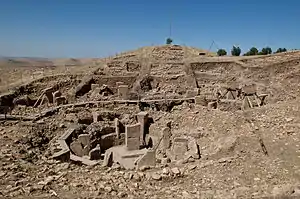
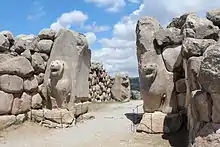
The Anatolian peninsula, comprising most of modern Turkey, is one of the oldest permanently settled regions in the world. Various ancient Anatolian populations have lived in Anatolia, from at least the Neolithic until the Hellenistic period.[13] Many of these peoples spoke the Anatolian languages, a branch of the larger Indo-European language family:[32] and, given the antiquity of the Indo-European Hittite and Luwian languages, some scholars have proposed Anatolia as the hypothetical centre from which the Indo-European languages radiated.[33] The European part of Turkey, called Eastern Thrace, has also been inhabited since at least forty thousand years ago, and is known to have been in the Neolithic era by about 6000 BC.[14]
Göbekli Tepe is the site of the oldest known man-made religious structure, a temple dating to circa 10,000 BC,[30] while Çatalhöyük is a very large Neolithic and Chalcolithic settlement in southern Anatolia, which existed from approximately 7500 BC to 5700 BC. It is the largest and best-preserved Neolithic site found to date and is a UNESCO World Heritage Site.[34] The settlement of Troy started in the Neolithic Age and continued into the Iron Age.[35]
The earliest recorded inhabitants of Anatolia were the Hattians and Hurrians, non-Indo-European peoples who inhabited central and eastern Anatolia, respectively, as early as c. 2300 BC. Indo-European Hittites came to Anatolia and gradually absorbed the Hattians and Hurrians c. 2000–1700 BC. The first major empire in the area was founded by the Hittites, from the 18th through the 13th century BC. The Assyrians conquered and settled parts of southeastern Turkey as early as 1950 BC until the year 612 BC,[36] although they have remained a minority in the region, namely in Hakkari, Şırnak and Mardin.[37]
Urartu re-emerged in Assyrian inscriptions in the 9th century BC as a powerful northern rival of Assyria.[38] Following the collapse of the Hittite empire c. 1180 BC, the Phrygians, an Indo-European people, achieved ascendancy in Anatolia until their kingdom was destroyed by the Cimmerians in the 7th century BC.[39] Starting from 714 BC, Urartu shared the same fate and dissolved in 590 BC,[40] when it was conquered by the Medes. The most powerful of Phrygia's successor states were Lydia, Caria and Lycia.
Antiquity
.jpg.webp)

Starting around 1200 BC, the coast of Anatolia was heavily settled by Aeolian and Ionian Greeks. Numerous important cities were founded by these colonists, such as Miletus, Ephesus, Smyrna (now İzmir) and Byzantium (now Istanbul), the latter founded by Greek colonists from Megara in 657 BC. The first state that was called Armenia by neighbouring peoples was the state of the Armenian Orontid dynasty, which included parts of eastern Turkey beginning in the 6th century BC. In Northwest Turkey, the most significant tribal group in Thrace was the Odyrisians, founded by Teres I.[44]
All of modern-day Turkey was conquered by the Persian Achaemenid Empire during the 6th century BC.[45] The Greco-Persian Wars started when the Greek city states on the coast of Anatolia rebelled against Persian rule in 499 BC. The territory of Turkey later fell to Alexander the Great in 334 BC,[46] which led to increasing cultural homogeneity and Hellenization in the area.[13]
Following Alexander's death in 323 BC, Anatolia was subsequently divided into a number of small Hellenistic kingdoms, all of which became part of the Roman Republic by the mid-1st century BC.[47] The process of Hellenization that began with Alexander's conquest accelerated under Roman rule, and by the early centuries of the Christian Era, the local Anatolian languages and cultures had become extinct, being largely replaced by ancient Greek language and culture.[15][48] From the 1st century BC up to the 3rd century CE, large parts of modern-day Turkey were contested between the Romans and neighbouring Parthians through the frequent Roman-Parthian Wars.
Early Christian and Byzantine period
.jpg.webp)
According to Acts of Apostles 11,[50] Antioch (now Antakya), a city in southern Turkey, is the birthplace of the first Christian community.[51]
In 324, Constantine I chose Byzantium to be the new capital of the Roman Empire, renaming it New Rome. Following the death of Theodosius I in 395 and the permanent division of the Roman Empire between his two sons, the city, which would popularly come to be known as Constantinople, became the capital of the Eastern Roman Empire. This empire, which would later be branded by historians as the Byzantine Empire, ruled most of the territory of present-day Turkey until the Late Middle Ages;[52] although the eastern regions remained firmly in Sasanian hands up to the first half of the seventh century. The frequent Byzantine-Sassanid Wars, as part of the centuries long-lasting Roman-Persian Wars, fought between the neighbouring rivalling Byzantines and Sasanians, took place in various parts of present-day Turkey and decided much of the latter's history from the fourth century up to the first half of the seventh century.
Several ecumenical councils of the early Church were held in cities located in present-day Turkey including the First Council of Nicaea (Iznik) in 325, the First Council of Constantinople (Istanbul) in 381, the Council of Ephesus in 431, and the Council of Chalcedon (Kadıköy) in 451.[53]
Seljuks and the Ottoman Empire
The House of Seljuk originated from the Kınık branch of the Oghuz Turks who resided on the periphery of the Muslim world, in the Yabgu Khaganate of the Oğuz confederacy, to the north of the Caspian and Aral Seas, in the 9th century.[54] In the 10th century, the Seljuks started migrating from their ancestral homeland into Persia, which became the administrative core of the Great Seljuk Empire, after its foundation by Tughril.[55]
In the latter half of the 11th century, the Seljuk Turks began penetrating into medieval Armenia and the eastern regions of Anatolia. In 1071, the Seljuks defeated the Byzantines at the Battle of Manzikert, starting the Turkification process in the area; the Turkish language and Islam were introduced to Armenia and Anatolia, gradually spreading throughout the region. The slow transition from a predominantly Christian and Greek-speaking Anatolia to a predominantly Muslim and Turkish-speaking one was underway. The Mevlevi Order of dervishes, which was established in Konya during the 13th century by Sufi poet Celaleddin Rumi, played a significant role in the Islamization of the diverse people of Anatolia who had previously been Hellenized.[56][57] Thus, alongside the Turkification of the territory, the culturally Persianized Seljuks set the basis for a Turko-Persian principal culture in Anatolia,[58] which their eventual successors, the Ottomans, would take over.[59][60]
In 1243, the Seljuk armies were defeated by the Mongols at the Battle of Köse Dağ, causing the Seljuk Empire's power to slowly disintegrate. In its wake, one of the Turkish principalities governed by Osman I would evolve over the next 200 years into the Ottoman Empire. The Ottomans completed their conquest of the Byzantine Empire by capturing its capital, Constantinople, in 1453: their commander thenceforth being known as Mehmed the Conqueror.
In 1514, Sultan Selim I (1512–1520) successfully expanded the empire's southern and eastern borders by defeating Shah Ismail I of the Safavid dynasty in the Battle of Chaldiran. In 1517, Selim I expanded Ottoman rule into Algeria and Egypt, and created a naval presence in the Red Sea. Subsequently, a contest started between the Ottoman and Portuguese empires to become the dominant sea power in the Indian Ocean, with a number of naval battles in the Red Sea, the Arabian Sea and the Persian Gulf. The Portuguese presence in the Indian Ocean was perceived as a threat to the Ottoman monopoly over the ancient trade routes between East Asia and Western Europe. Despite the increasingly prominent European presence, the Ottoman Empire's trade with the east continued to flourish until the second half of the 18th century.[63]
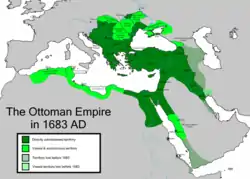
The Ottoman Empire's power and prestige peaked in the 16th and 17th centuries, particularly during the reign of Suleiman the Magnificent, who personally instituted major legislative changes relating to society, education, taxation and criminal law. The empire was often at odds with the Holy Roman Empire in its steady advance towards Central Europe through the Balkans and the southern part of the Polish–Lithuanian Commonwealth.[64] The Ottoman Navy contended with several Holy Leagues, such as those in 1538, 1571, 1684 and 1717 (composed primarily of Habsburg Spain, the Republic of Genoa, the Republic of Venice, the Knights of St. John, the Papal States, the Grand Duchy of Tuscany and the Duchy of Savoy), for the control of the Mediterranean Sea. In the east, the Ottomans were often at war with Safavid Persia over conflicts stemming from territorial disputes or religious differences between the 16th and 18th centuries.[65] The Ottoman wars with Persia continued as the Zand, Afsharid, and Qajar dynasties succeeded the Safavids in Iran, until the first half of the 19th century. Even further east, there was an extension of the Habsburg-Ottoman conflict, in that the Ottomans also had to send soldiers to their farthest and easternmost vassal and territory, the Aceh Sultanate[66][67] in Southeast Asia, to defend it from European colonizers as well as the Latino invaders who had crossed from Latin America and had Christianized the formerly Muslim-dominated Philippines.[68] From the 16th to the early 20th centuries, the Ottoman Empire also fought twelve wars with the Russian Tsardom and Empire. These were initially about Ottoman territorial expansion and consolidation in southeastern and eastern Europe; but starting from the Russo-Turkish War (1768–1774), they became more about the survival of the Ottoman Empire, which had begun to lose its strategic territories on the northern Black Sea coast to the advancing Russians.
From the second half of the 18th century onwards, the Ottoman Empire began to decline. The Tanzimat reforms, initiated by Mahmud II just before his death in 1839, aimed to modernise the Ottoman state in line with the progress that had been made in Western Europe. The efforts of Midhat Pasha during the late Tanzimat era led the Ottoman constitutional movement of 1876, which introduced the First Constitutional Era, but these efforts proved to be inadequate in most fields, and failed to stop the dissolution of the empire.[69] As the empire gradually shrank in size, military power and wealth; especially after the Ottoman economic crisis and default in 1875[70] which led to uprisings in the Balkan provinces that culminated in the Russo-Turkish War (1877–1878); many Balkan Muslims migrated to the Empire's heartland in Anatolia,[71][72] along with the Circassians fleeing the Russian conquest of the Caucasus. The decline of the Ottoman Empire led to a rise in nationalist sentiment among its various subject peoples, leading to increased ethnic tensions which occasionally burst into violence, such as the Hamidian massacres of Armenians.[73]

The loss of Rumelia (Ottoman territories in Europe) with the First Balkan War (1912–1913) was followed by the arrival of millions of Muslim refugees (muhacir) to Istanbul and Anatolia.[75] Historically, the Rumelia Eyalet and Anatolia Eyalet had formed the administrative core of the Ottoman Empire, with their governors titled Beylerbeyi participating in the Sultan's Divan, so the loss of all Balkan provinces beyond the Midye-Enez border line according to the London Conference of 1912–13 and the Treaty of London (1913) was a major shock for the Ottoman society and led to the 1913 Ottoman coup d'état. In the Second Balkan War (1913) the Ottomans managed to recover their former capital Edirne (Adrianople) and its surrounding areas in East Thrace, which was formalised with the Treaty of Constantinople (1913). The 1913 coup d'état effectively put the country under the control of the Three Pashas, making sultans Mehmed V and Mehmed VI largely symbolic figureheads with no real political power.
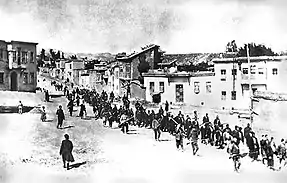
The Ottoman Empire entered World War I on the side of the Central Powers and was ultimately defeated. The Ottomans successfully defended the Dardanelles strait during the Gallipoli campaign (1915–1916) and achieved initial victories against British forces in the first two years of the Mesopotamian campaign, such as the Siege of Kut (1915–1916); but the Arab Revolt (1916–1918) turned the tide against the Ottomans in the Middle East. In the Caucasus campaign, however, the Russian forces had the upper hand from the beginning, especially after the Battle of Sarikamish (1914–1915). Russian forces advanced into northeastern Anatolia and controlled the major cities there until retreating from World War I with the Treaty of Brest-Litovsk following the Russian Revolution (1917). During the war, the empire's Armenians were deported to Syria as part of the Armenian Genocide. As a result, an estimated 800,000 to 1,500,000 Armenians were killed.[76][77][78][79] The Turkish government has refused to acknowledge the events as genocide and states that Armenians were only relocated from the eastern war zone.[80] Genocidal campaigns were also committed against the empire's other minority groups such as the Assyrians and Greeks.[81][82][83] Following the Armistice of Mudros on 30 October 1918, the victorious Allied Powers sought to partition the Ottoman state through the 1920 Treaty of Sèvres.[84]
Republic of Turkey

The occupation of Istanbul (1918) and İzmir (1919) by the Allies in the aftermath of World War I prompted the establishment of the Turkish National Movement. Under the leadership of Mustafa Kemal Pasha, a military commander who had distinguished himself during the Battle of Gallipoli, the Turkish War of Independence (1919–1923) was waged with the aim of revoking the terms of the Treaty of Sèvres (1920).[85]
By 18 September 1922 the Greek, Armenian and French armies had been expelled,[86] and the Turkish Provisional Government in Ankara, which had declared itself the legitimate government of the country on 23 April 1920, started to formalise the legal transition from the old Ottoman into the new Republican political system. On 1 November 1922, the Turkish Parliament in Ankara formally abolished the Sultanate, thus ending 623 years of monarchical Ottoman rule. The Treaty of Lausanne of 24 July 1923, which superseded the Treaty of Sèvres,[84][85] led to the international recognition of the sovereignty of the newly formed "Republic of Turkey" as the successor state of the Ottoman Empire, and the republic was officially proclaimed on 29 October 1923 in Ankara, the country's new capital.[87] The Lausanne Convention stipulated a population exchange between Greece and Turkey, whereby 1.1 million Greeks left Turkey for Greece in exchange for 380,000 Muslims transferred from Greece to Turkey.[88]
.jpg.webp)
Mustafa Kemal became the republic's first President and subsequently introduced many reforms. The reforms aimed to transform the old religion-based and multi-communal Ottoman constitutional monarchy into a Turkish nation state that would be governed as a parliamentary republic under a secular constitution.[90] With the Surname Law of 1934, the Turkish Parliament bestowed upon Mustafa Kemal the honorific surname "Atatürk" (Father Turk).[85]
The Montreux Convention (1936) restored Turkey's control over the Turkish Straits, including the right to militarise the coastlines of the Dardanelles and Bosporus straits and the Sea of Marmara, and to block maritime traffic in wartime.[91]
Following the establishment of the Republic of Turkey in 1923, some Kurdish and Zaza tribes, which were feudal (manorial) communities led by chieftains (agha) during the Ottoman period, became discontent about certain aspects of Atatürk's reforms aiming to modernise the country, such as secularism (the Sheikh Said rebellion, 1925)[92] and land reform (the Dersim rebellion, 1937–1938),[93] and staged armed revolts that were put down with military operations.
İsmet İnönü became Turkey's second President following Atatürk's death on 10 November 1938. On 29 June 1939, the Republic of Hatay voted in favour of joining Turkey with a referendum. Turkey remained neutral during most of World War II, but entered the closing stages of the war on the side of the Allies on 23 February 1945. On 26 June 1945, Turkey became a charter member of the United Nations.[94] In the following year, the single-party period in Turkey came to an end, with the first multiparty elections in 1946. In 1950 Turkey became a member of the Council of Europe.
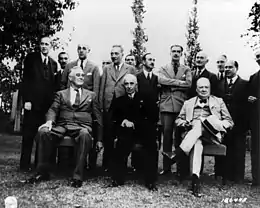
The Democratic Party established by Celâl Bayar won the 1950, 1954 and 1957 general elections and stayed in power for a decade, with Adnan Menderes as the Prime Minister and Bayar as the President. After fighting as part of the United Nations forces in the Korean War, Turkey joined NATO in 1952, becoming a bulwark against Soviet expansion into the Mediterranean. Turkey subsequently became a founding member of the OECD in 1961, and an associate member of the EEC in 1963.[95]
The country's tumultuous transition to multiparty democracy was interrupted by military coups d'état in 1960 and 1980, as well as by military memorandums in 1971 and 1997.[96][97] Between 1960 and the end of the 20th century, the prominent leaders in Turkish politics who achieved multiple election victories were Süleyman Demirel, Bülent Ecevit and Turgut Özal.
Following a decade of Cypriot intercommunal violence and the coup in Cyprus on 15 July 1974 staged by the EOKA B paramilitary organisation, which overthrew President Makarios and installed the pro-Enosis (union with Greece) Nikos Sampson as dictator, Turkey invaded Cyprus on 20 July 1974 by unilaterally exercising Article IV in the Treaty of Guarantee (1960), but without restoring the status quo ante at the end of the military operation.[98] In 1983 the Turkish Republic of Northern Cyprus, which is recognised only by Turkey, was established.[99] The Annan Plan for reunifying the island was supported by the majority of Turkish Cypriots, but rejected by the majority of Greek Cypriots, in separate referendums in 2004. However, negotiations for solving the Cyprus dispute are still ongoing between Turkish Cypriot and Greek Cypriot political leaders.[100]
The conflict between Turkey and the PKK (designated a terrorist organisation by Turkey, the United States,[101] the European Union[102] and NATO[103]) has been active since 1984, primarily in the southeast of the country. More than 40,000 people have died as a result of the conflict.[104][105][106] In 1999 PKK's founder Abdullah Öcalan was arrested and sentenced for terrorism[101][102] and treason charges.[107][108] In the past, various Kurdish groups have unsuccessfully sought separation from Turkey to create an independent Kurdish state, while others have more recently pursued provincial autonomy and greater political and cultural rights for Kurds in Turkey. In the 21st century some reforms have taken place to improve the cultural rights of ethnic minorities in Turkey, such as the establishment of TRT Kurdî, TRT Arabi and TRT Avaz by the TRT.
Since the liberalisation of the Turkish economy in the 1980s, the country has enjoyed stronger economic growth and greater political stability.[109] Turkey applied for full membership of the EEC in 1987, joined the EU Customs Union in 1995 and started accession negotiations with the European Union in 2005.[110][111] In a non-binding vote on 13 March 2019, the European Parliament called on the EU governments to suspend EU accession talks with Turkey, citing violations of human rights and the rule of law; but the negotiations, effectively on hold since 2018, remain active as of 2020.[27]
In 2013, widespread protests erupted in many Turkish provinces, sparked by a plan to demolish Gezi Park but soon growing into general anti-government dissent.[112] On 15 July 2016, an unsuccessful coup attempt tried to oust the government.[113] As a reaction to the failed coup d'état, the government carried out mass purges.[114][115]
Between 9 October – 25 November 2019, Turkey conducted a military offensive into north-eastern Syria.[116][117][118]
Administrative divisions
Turkey has a unitary structure in terms of administration and this aspect is one of the most important factors shaping the Turkish public administration. When three powers (executive, legislative and judiciary) are taken into account as the main functions of the state, local administrations have little power. Turkey does not have a federal system, and the provinces are subordinate to the central government in Ankara. Local administrations were established to provide services in place and the government is represented by the province governors (vali) and town governors (kaymakam). Other senior public officials are also appointed by the central government instead of the mayors (belediye başkanı) or elected by constituents.[119] Turkish municipalities have local legislative bodies (belediye meclisi) for decision-making on municipal issues.
Within this unitary framework, Turkey is subdivided into 81 provinces (il or vilayet) for administrative purposes. Each province is divided into districts (ilçe), for a total of 973 districts.[120] Turkey is also subdivided into 7 regions (bölge) and 21 subregions for geographic, demographic and economic purposes; this does not refer to an administrative division. The centralised structure of decision-making in Ankara is stated by some academics as an impediment to good local governance,[121][122] and occasionally causes resentment in the municipalities of urban centres that are inhabited largely by ethnic minority groups, such as the Kurds.[123][124][125] Steps towards decentralisation since 2004 have proven to be a highly controversial topic in Turkey.[121][122] The efforts to decentralise the administrative structure are also driven by the European Charter of Local Self-Government and with Chapter 22 ("Regional Policy & Coordination of Structural Instruments") of the acquis of the European Union.[126][127] A decentralisation program for Turkey has been a topic of discussion in the country's academics, politics and the broader public.[128][129]
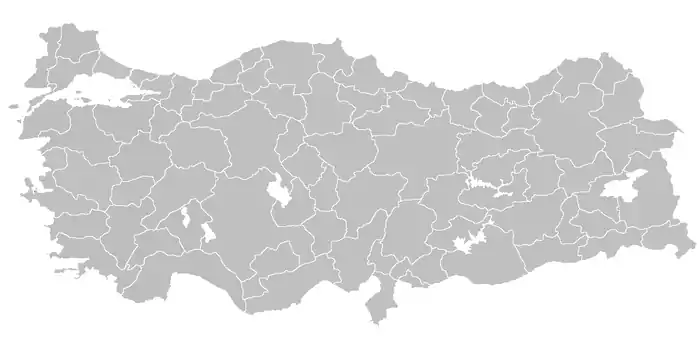
Politics
Between 1923 and 2018, Turkey was a parliamentary representative democracy. A presidential system was adopted by referendum in 2017; the new system came into effect with the presidential election in 2018 and gives the President complete control of the executive, including the power to issue decrees, appoint his own cabinet, draw up the budget, dissolve parliament by calling early elections, and make appointments to the bureaucracy and the courts.[130] The office of Prime Minister has been abolished and its powers (together with those of the Cabinet) have been transferred to the President, who is the head of state and is elected for a five-year term by direct elections.[130] Recep Tayyip Erdoğan is the first president elected by direct voting. Turkey's constitution governs the legal framework of the country. It sets out the main principles of government and establishes Turkey as a unitary centralised state.
Executive power is exercised by the President, while the legislative power is vested in the unicameral parliament, called the Grand National Assembly of Turkey. The judiciary is nominally independent from the executive and the legislature, but the constitutional changes that came into effect with the referendums in 2007, 2010 and 2017 gave larger powers to the President and the ruling party for appointing or dismissing judges and prosecutors.[131] The Constitutional Court is charged with ruling on the conformity of laws and decrees with the constitution. The Council of State is the tribunal of last resort for administrative cases, and the High Court of Appeals for all others.[132]
Universal suffrage for both sexes has been applied throughout Turkey since 1933 and before most countries, and every Turkish citizen who has turned 18 years of age has the right to vote. There are 600 members of parliament who are elected for a four-year term by a party-list proportional representation system from 85 electoral districts. The Constitutional Court can strip the public financing of political parties that it deems anti-secular or separatist, or ban their existence altogether.[133][134] The electoral threshold is ten percent of the votes.[135]
Supporters of Atatürk's reforms are called Kemalists, as distinguished from Islamists, representing the two diverging views regarding the role of religion in legislation, education and public life.[136] The Kemalist view supports a form of democracy with a secular constitution and Westernised culture, while maintaining the necessity of state intervention in the economy, education and other public services.[136] Since its foundation as a republic in 1923, Turkey has developed a strong tradition of secularism.[137] However, since the 1980s, issues such as income inequality and class distinction have given rise to Islamism, a movement that supports a larger role for religion in government policies, and in theory supports obligation to authority, communal solidarity and social justice; though what that entails in practice is often contested.[136] Turkey under Recep Tayyip Erdoğan and the AKP has been described as becoming increasingly authoritarian.[138][139][140][141] Even before the constitutional referendum in 2017 the Council of Europe said the country had autocratic tendencies and warned of a "dramatic regression of [Turkey's] democratic order".[142][143][144] Many elements in the constitutional reform package that was approved with the referendum in 2017 have increased concerns in the European Union regarding democracy and the separation of powers in Turkey.[145][146][147][148]
In 2017 the Economist Intelligence Unit's Democracy Index rated Turkey at 4.88 (on a 0–10 scale), classifying Turkey as a hybrid regime.[149] In 2018, Freedom House rated Turkey at 32 (on a 0–100 scale) as Not Free.[150] In 2019 Turkey ranked 110th out of 167 countries in the Democracy Index.[151]
Law
Turkey's judicial system has been wholly integrated with the system of continental Europe. For instance, the Turkish Civil Code has been modified by incorporating elements mainly of the Swiss Civil Code and Code of Obligations, and the German Commercial Code. The Administrative Code bears similarities with its French counterpart, and the Penal Code with its Italian counterpart.[152]
Turkey has adopted the principle of the separation of powers. In line with this principle, judicial power is exercised by independent courts on behalf of the Turkish nation. The independence and organisation of the courts, the security of the tenure of judges and public prosecutors, the profession of judges and prosecutors, the supervision of judges and public prosecutors, the military courts and their organisation, and the powers and duties of the high courts are regulated by the Turkish Constitution.[153]
According to Article 142 of the Turkish Constitution, the organisation, duties and jurisdiction of the courts, their functions and the trial procedures are regulated by law. In line with the aforementioned article of the Turkish Constitution and related laws, the court system in Turkey can be classified under three main categories; which are the Judicial Courts, Administrative Courts and Military Courts. Each category includes first instance courts and high courts. In addition, the Court of Jurisdictional Disputes rules on cases that cannot be classified readily as falling within the purview of one court system.[153]
Law enforcement in Turkey is carried out by several departments (such as the General Directorate of Security and Gendarmerie General Command) and agencies, all acting under the command of the President of Turkey or mostly the Minister of Internal Affairs. According to figures released by the Justice Ministry, there are 100,000 people in Turkish prisons as of November 2008, a doubling since 2000.[154]
In the years of government by the AKP and Erdoğan, particularly since 2013, the independence and integrity of the Turkish judiciary has increasingly been said to be in doubt by institutions, parliamentarians and journalists both within and outside of Turkey; due to political interference in the promotion of judges and prosecutors, and in their pursuit of public duty.[155][156][157][158] The Turkey 2015 report of the European Commission stated that "the independence of the judiciary and respect of the principle of separation of powers have been undermined and judges and prosecutors have been under strong political pressure."[155]
Foreign relations
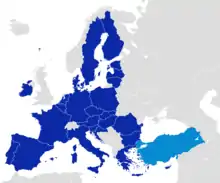
Turkey is a founding member of the United Nations (1945),[159] the OECD (1961),[160] the OIC (1969),[161] the OSCE (1973),[162] the ECO (1985),[163] the BSEC (1992),[164] the D-8 (1997)[165] and the G20 (1999).[166] Turkey was a member of the United Nations Security Council in 1951–1952, 1954–1955, 1961 and 2009–2010.[167] In 2012 Turkey became a dialogue partner of the SCO, and in 2013 became a member of the ACD.[168][169]
In line with its traditional Western orientation, relations with Europe have always been a central part of Turkish foreign policy. Turkey became one of the early members of the Council of Europe in 1950, applied for associate membership of the EEC (predecessor of the European Union) in 1959 and became an associate member in 1963. After decades of political negotiations, Turkey applied for full membership of the EEC in 1987, became an associate member of the Western European Union in 1992, joined the EU Customs Union in 1995 and has been in formal accession negotiations with the EU since 2005.[110][111] Today, EU membership is considered as a state policy and a strategic target by Turkey. Turkey's support for Northern Cyprus in the Cyprus dispute complicates Turkey's relations with the EU and remains a major stumbling block to the country's EU accession bid.[170]
The other defining aspect of Turkey's foreign policy was the country's long-standing strategic alliance with the United States.[171][172] The Truman Doctrine in 1947 enunciated American intentions to guarantee the security of Turkey and Greece during the Cold War, and resulted in large-scale U.S. military and economic support. In 1948 both countries were included in the Marshall Plan and the OEEC for rebuilding European economies.[173] The common threat posed by the Soviet Union during the Cold War led to Turkey's membership of NATO in 1952, ensuring close bilateral relations with the US. Subsequently, Turkey benefited from the United States' political, economic and diplomatic support, including in key issues such as the country's bid to join the European Union.[174] In the post–Cold War environment, Turkey's geostrategic importance shifted towards its proximity to the Middle East, the Caucasus and the Balkans.[175]
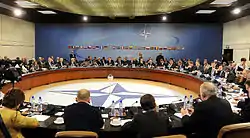
The independence of the Turkic states of the Soviet Union in 1991, with which Turkey shares a common cultural and linguistic heritage, allowed Turkey to extend its economic and political relations deep into Central Asia,[177] thus enabling the completion of a multi-billion-dollar oil and natural gas pipeline from Baku in Azerbaijan to the port of Ceyhan in Turkey. The Baku–Tbilisi–Ceyhan pipeline forms part of Turkey's foreign policy strategy to become an energy conduit from the Caspian Sea basin to Europe. However, in 1993, Turkey sealed its land border with Armenia in a gesture of support to Azerbaijan (a Turkic state in the Caucasus region) during the First Nagorno-Karabakh War, and it remains closed.[178]
Under the AKP government, Turkey's influence has grown in the formerly Ottoman territories of the Middle East and the Balkans, based on the "strategic depth" doctrine (a terminology that was coined by Ahmet Davutoğlu for defining Turkey's increased engagement in regional foreign policy issues), also called Neo-Ottomanism.[179][180] Following the Arab Spring in December 2010, the choices made by the AKP government for supporting certain political opposition groups in the affected countries have led to tensions with some Arab states, such as Turkey's neighbour Syria since the start of the Syrian civil war, and Egypt after the ousting of President Mohamed Morsi.[181][182] As of 2016, Turkey does not have an ambassador in either Syria or Egypt.[183] Diplomatic relations with Israel were also severed after the Gaza flotilla raid in 2010, but were normalised following a deal in June 2016.[184] These political rifts have left Turkey with few allies in the East Mediterranean, where rich natural gas fields have recently been discovered;[185][186] in sharp contrast with the original goals that were set by the former Foreign Minister (later Prime Minister) Ahmet Davutoğlu in his "zero problems with neighbours"[187][188] foreign policy doctrine.[189] In 2015, Turkey, Saudi Arabia and Qatar formed a "strategic alliance" against Syrian President Bashar al-Assad.[190] However, following the rapprochement with Russia in 2016, Turkey revised its stance regarding the solution of the conflict in Syria.[191][192][193] In January 2018, the Turkish military and the Turkish-backed forces, including the Free Syrian Army and Ahrar al-Sham,[194] began an intervention in Syria aimed at ousting U.S.-backed YPG from the enclave of Afrin.[195][196] In 2020, Turkey openly intervened in Libya at the request of the GNA.[197] There is a dispute over Turkey's maritime boundaries with Greece and Cyprus and drilling rights in the eastern Mediterranean.[198][199] Turkey recognizes and supports the Tripoli-based Government of National Accord (GNA) in Libya, which has been torn by a civil war since 2014.
Military
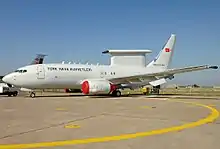
The Turkish Armed Forces consist of the Land Forces, the Naval Forces and the Air Force. The Gendarmerie and the Coast Guard operate as parts of the Ministry of Internal Affairs in peacetime, although they are subordinated to the Army and Navy Commands respectively in wartime, during which they have both internal law-enforcement and military functions.[200] The Chief of the General Staff is appointed by the President. The Council of Ministers is responsible to the Parliament for matters of national security and the adequate preparation of the armed forces to defend the country. However, the authority to declare war and to deploy the Turkish Armed Forces to foreign countries or to allow foreign armed forces to be stationed in Turkey rests solely with the Parliament.[200]
.jpg.webp)
Every fit male Turkish citizen otherwise not barred is required to serve in the military for a period ranging from three weeks to a year, dependent on education and job location.[203] Turkey does not recognise conscientious objection and does not offer a civilian alternative to military service.[204]
Turkey has the second-largest standing military force in NATO, after the US Armed Forces, with an estimated strength of 495,000 deployable forces, according to a 2011 NATO estimate.[205] Turkey is one of five NATO member states which are part of the nuclear sharing policy of the alliance, together with Belgium, Germany, Italy, and the Netherlands.[206] A total of 90 B61 nuclear bombs are hosted at the Incirlik Air Base, 40 of which are allocated for use by the Turkish Air Force in case of a nuclear conflict, but their use requires the approval of NATO.[207]
Turkey has maintained forces in international missions under the United Nations and NATO since the Korean War, including peacekeeping missions in Somalia, Yugoslavia and the Horn of Africa. Turkey supported the coalition forces in the First Gulf War. Turkish Armed Forces contribute military personnel to the International Security Assistance Force, Kosovo Force, Eurocorps and EU Battlegroups.[208][209] Turkey maintains a force of 36,000 troops in Northern Cyprus since 1974.[210] In recent years, Turkey has assisted Peshmerga forces in northern Iraq and the Somali Armed Forces with security and training.[211][212] Turkish Armed Forces have overseas military bases in Albania,[213] Iraq,[214] Qatar,[215] and Somalia.[216]
In the 2016 Global Peace Index, Turkey ranked 145th out of 163 countries in the world, mainly because of its "increasingly strained relations with its neighbors", according to Forbes.[217]
Human rights

The human rights record of Turkey has been the subject of much controversy and international condemnation. Between 1959 and 2011 the European Court of Human Rights made more than 2400 judgements against Turkey for human rights violations on issues such as Kurdish rights, women's rights, LGBT rights, and media freedom.[218][219] Turkey's human rights record continues to be a significant obstacle to the country's membership of the EU.[220]
In the latter half of the 1970s, Turkey suffered from political violence between far-left and far-right militant groups, which culminated in the military coup of 1980.[221] The Kurdistan Workers' Party (designated a terrorist organisation by Turkey, the United States,[101] the European Union[102] and NATO[103]) was founded in 1978 by a group of Kurdish militants led by Abdullah Öcalan, seeking the foundation of an independent, Marxist-Leninist state in the region, which was to be known as Kurdistan.[222] The initial reason given by the PKK for this was the oppression of Kurds in Turkey.[223][224] A full-scale insurgency began in 1984, when the PKK announced a Kurdish uprising. Following the arrest and imprisonment of Abdullah Öcalan in 1999,[107][108] the PKK modified its demands into equal rights for ethnic Kurds and provincial autonomy within Turkey.[225][226][227][228] Since the conflict began, more than 40,000 people have died, most of whom were Turkish Kurds.[229] The European Court of Human Rights and other international human rights organisations have condemned Turkey for human rights abuses.[218][219] Many judgments are related to cases such as civilian deaths in aerial bombardments,[230] torturing,[231] forced displacements,[232] destroyed villages,[233][234][235] arbitrary arrests,[236] murdered and disappeared Kurdish journalists, activists and politicians.[237]
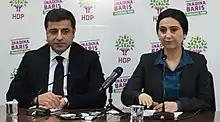
On 20 May 2016, the Turkish parliament stripped almost a quarter of its members of immunity from prosecution, including 101 deputies from the pro-Kurdish HDP and the main opposition CHP party.[238] In reaction to the failed coup attempt on 15 July 2016, over 160,000 judges, teachers, police and civil servants have been suspended or dismissed, 77,000 have been formally arrested,[239][240] and 130 media organisations, including 16 television broadcasters and 45 newspapers,[241] have been closed by the government of Turkey.[242] 160 journalists have been imprisoned.[243]
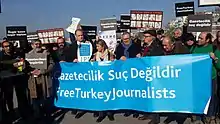
According to the Committee to Protect Journalists, the AKP government has waged one of the world's biggest crackdowns on media freedom.[244][245] Many journalists have been arrested using charges of "terrorism" and "anti-state activities" such as the Ergenekon and Balyoz cases, while thousands have been investigated on charges such as "denigrating Turkishness" or "insulting Islam" in an effort to sow self-censorship.[244] In 2017, the CPJ identified 81 jailed journalists in Turkey (including the editorial staff of Cumhuriyet, Turkey's oldest newspaper still in circulation), all directly held for their published work (the country ranked first in the world in that year, with more journalists in prison than in Iran, Eritrea or China);[245] while in 2015 Freemuse identified nine musicians imprisoned for their work (ranking third after Russia and China).[246] In 2015 Turkey's media was rated as not free by Freedom House.[247] In its resolution "The functioning of democratic institutions in Turkey" on 22 June 2016, the Parliamentary Assembly of the Council of Europe warned that "recent developments in Turkey pertaining to freedom of the media and of expression, erosion of the rule of law and the human rights violations in relation to anti-terrorism security operations in south-east Turkey have (...) raised serious questions about the functioning of its democratic institutions."[248]
Renowned Turkish journalists who were murdered for their opinions include Abdi İpekçi (1929–1979, editor-in-chief of Milliyet); Çetin Emeç (1935–1990, chief columnist and coordinator of Hürriyet); Uğur Mumcu (1942–1993, columnist and investigative journalist of Cumhuriyet); and Hrant Dink (1954–2007, founder and editor-in-chief of Agos).
During the October 2019 offensive into Syria, Turkish forces have been accused of war crimes, such as targeting civilians with white phosphorus and various other human rights violations.[249][250] Turkey has officially rejected the claims, with the Minister of Defense Hulusi Akar stating that chemical weapons don't exist in the inventory of the Turkish Armed Forces.[251]
Amnesty International stated that it had gathered evidence of war crimes and other violations committed by Turkish and Turkey-backed Syrian forces who are said to "have displayed a shameful disregard for civilian life, carrying out serious violations and war crimes, including summary killings and unlawful attacks that have killed and injured civilians".[252]
Geography
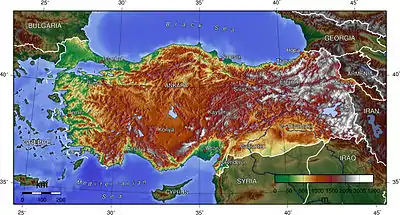
Turkey is a transcontinental Eurasian country.[253][254] Asian Turkey, which includes 97 percent of the country, is separated from European Turkey by the Bosphorus, the Sea of Marmara, and the Dardanelles. European Turkey comprises 3 percent of the country's territory.[255] The territory of Turkey is more than 1,600 kilometres (990 miles) long and 800 kilometres (500 miles) wide, with a roughly rectangular shape.[256] It lies between latitudes 35° and 43° N, and longitudes 25° and 45° E. Turkey's land area, including lakes, occupies 783,562 square kilometres (302,535 square miles),[257] of which 755,688 square kilometres (291,773 square miles) are in Southwest Asia and 23,764 square kilometres (9,175 square miles) in Europe.[256] Turkey is the world's 37th-largest country in terms of area. The country is encircled by seas on three sides: the Aegean Sea to the west, the Black Sea to the north and the Mediterranean to the south. Turkey also contains the Sea of Marmara in the northwest.[258]
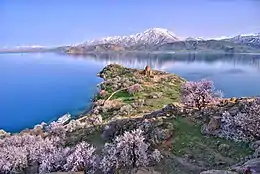
The European section of Turkey, also known as East Thrace (Turkish: Trakya) is located at the easternmost edge the Balkan peninsula. It forms the border between Turkey and its neighbours Greece and Bulgaria. The Asian part of the country mostly consists of the peninsula of Anatolia, which consists of a high central plateau with narrow coastal plains, between the Köroğlu and Pontic mountain ranges to the north and the Taurus Mountains to the south. Eastern Turkey has a more mountainous landscape and is home to the sources of rivers such as the Euphrates, Tigris and Aras. The western portion of the Armenian highland is located in eastern Turkey;[260] this region contains Mount Ararat, Turkey's highest point at 5,137 metres (16,854 feet),[261] and Lake Van, the largest lake in the country.[259] Southeastern Turkey is located within the northern plains of Upper Mesopotamia.
Turkey is divided into seven geographical regions: Marmara, Aegean, Black Sea, Central Anatolia, Eastern Anatolia, Southeastern Anatolia and the Mediterranean. The uneven north Anatolian terrain running along the Black Sea resembles a long, narrow belt. This region comprises approximately one-sixth of Turkey's total land area. As a general trend, the inland Anatolian plateau becomes increasingly rugged as it progresses eastward.[258]
Turkey's varied landscapes are the product of complex earth movements that have shaped the region over thousands of years and still manifest themselves in fairly frequent earthquakes and occasional volcanic eruptions. The Bosphorus and the Dardanelles owe their existence to the fault lines running through Turkey that led to the creation of the Black Sea. The North Anatolian Fault Line runs across the north of the country from west to east, along which major earthquakes took place in history. The latest of those big earthquakes was the 1999 İzmit earthquake.
Biodiversity
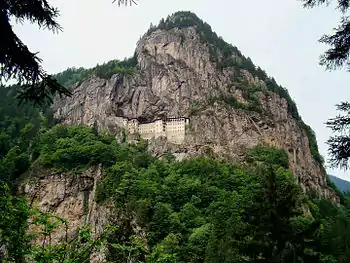
Turkey's extraordinary ecosystem and habitat diversity has produced considerable species diversity.[262] Anatolia is the homeland of many plants that have been cultivated for food since the advent of agriculture, and the wild ancestors of many plants that now provide staples for humankind still grow in Turkey. The diversity of Turkey's fauna is even greater than that of its flora. The number of animal species in the whole of Europe is around 60,000, while in Turkey there are over 80,000 (over 100,000 counting the subspecies).[263]
The Northern Anatolian conifer and deciduous forests is an ecoregion which covers most of the Pontic Mountains in northern Turkey, while the Caucasus mixed forests extend across the eastern end of the range. The region is home to Eurasian wildlife such as the Eurasian sparrowhawk, golden eagle, eastern imperial eagle, lesser spotted eagle, Caucasian black grouse, red-fronted serin, and wallcreeper.[264] The narrow coastal strip between the Pontic Mountains and the Black Sea is home to the Euxine-Colchic deciduous forests, which contain some of the world's few temperate rainforests.[265] The Turkish pine is mostly found in Turkey and other east Mediterranean countries. Several wild species of tulip are native to Anatolia, and the flower was first introduced to Western Europe with species taken from the Ottoman Empire in the 16th century.[266][267]
There are 40 national parks, 189 nature parks, 31 nature preserve areas, 80 wildlife protection areas and 109 nature monuments in Turkey such as Gallipoli Peninsula Historical National Park, Mount Nemrut National Park, Ancient Troya National Park, Ölüdeniz Nature Park and Polonezköy Nature Park.[268]
The Anatolian leopard is still found in very small numbers in the northeastern and southeastern regions of Turkey.[269][270] The Eurasian lynx and the European wildcat are other felid species which are currently found in the forests of Turkey.
The Caspian tiger, now extinct, lived in the easternmost regions of Turkey until the latter half of the 20th century.[269][271] In the 21st century threats to biodiversity include desertification due to climate change in Turkey.[272]
Renowned domestic animals from Ankara, the capital of Turkey, include the Angora cat, Angora rabbit and Angora goat; and from Van Province the Van cat. The national dog breeds are the Kangal, Malaklı, Akbaş and Anatolian Shepherd.[273]
Turkey had a 2019 Forest Landscape Integrity Index mean score of 6.39/10, ranking it 75th globally out of 172 countries.[274]
Climate
.png.webp)
The coastal areas of Turkey bordering the Aegean and Mediterranean Seas have a temperate Mediterranean climate, with hot, dry summers and mild to cool, wet winters.[275] The coastal areas bordering the Black Sea have a temperate oceanic climate with warm, wet summers and cool to cold, wet winters.[275] The Turkish Black Sea coast receives the greatest amount of precipitation and is the only region of Turkey that receives high precipitation throughout the year.[275] The eastern part of that coast averages 2,200 millimetres (87 in) annually which is the highest precipitation in the country.[275]
The coastal areas bordering the Sea of Marmara, which connects the Aegean Sea and the Black Sea, have a transitional climate between a temperate Mediterranean climate and a temperate oceanic climate with warm to hot, moderately dry summers and cool to cold, wet winters.[275] Snow falls on the coastal areas of the Sea of Marmara and the Black Sea almost every winter, but usually melts in no more than a few days.[275] However snow is rare in the coastal areas of the Aegean Sea and very rare in the coastal areas of the Mediterranean Sea.[275]
Mountains close to the coast prevent Mediterranean influences from extending inland, giving the central Anatolian plateau of the interior of Turkey a continental climate with sharply contrasting seasons.[275]
Winters on the eastern part of the plateau are especially severe.[275] Temperatures of −30 to −40 °C (−22 to −40 °F) can occur in eastern Anatolia.[275] Snow may remain at least 120 days of the year.[275] In the west, winter temperatures average below 1 °C (34 °F).[275] Summers are hot and dry, with temperatures often above 30 °C (86 °F) in the day.[275] Annual precipitation averages about 400 millimetres (16 inches), with actual amounts determined by elevation. The driest regions are the Konya Plain and the Malatya Plain, where annual rainfall is often less than 300 millimetres (12 inches). May is generally the wettest month, whereas July and August are the driest.[275]
Turkey has signed but not ratified global agreements on reducing greenhouse gas emissions: the country has not yet ratified the Kigali Accord to regulate hydrofluorocarbons, and is one of the few countries that have not ratified the Paris agreement on climate change.
Economy
With an estimated nominal gross domestic product of $744 billion ($8,958 per capita) and $2.4 trillion ($28,264 p.c.) in purchasing power parity,[276][277] Turkey is the world's 19th largest economy and 13th largest by PPP.[278][279] The country is among the founding members of the OECD and the G20.[160][166]
The EU – Turkey Customs Union in 1995 led to an extensive liberalisation of tariff rates, and forms one of the most important pillars of Turkey's foreign trade policy.[280]
The automotive industry in Turkey is sizeable, and produced over 1.3 million motor vehicles in 2015, ranking as the 14th largest producer in the world.[281] Turkish shipyards are highly regarded both for the production of chemical and oil tankers up to 10,000 dwt and also for their mega yachts.[282] Turkish brands like Beko and Vestel are among the largest producers of consumer electronics and home appliances in Europe, and invest a substantial amount of funds for research and development in new technologies related to these fields.[283][284][285]
Other key sectors of the Turkish economy are banking, construction, home appliances, electronics, textiles, oil refining, petrochemical products, food, mining, iron and steel, and machine industry. However, agriculture still accounted for a quarter of employment.[289] In 2004, it was estimated that 46 percent of total disposable income was received by the top 20 percent of income earners, while the lowest 20 percent received only 6 percent.[290] The rate of female employment in Turkey was 30 percent in 2012,[291] the lowest among all OECD countries.[292]
Foreign direct investment (FDI) was $8.3 billion in 2012, a figure expected to rise to $15 billion in 2013.[293] In the economic crisis of 2016 it emerged that the huge debts incurred for investment during the AKP government since 2002 had mostly been consumed in construction, rather than invested in sustainable economic growth.[294] Turkey's gross external debt reached $453.2 billion at the end of December 2017.[295] Turkey's annual current account deficit was $47.3 billion at the end of December 2017, compared to the previous year's figure of $33.1 billion.[296] In 2020, according to Carbon Tracker, money was being wasted constructing more coal-fired power stations in Turkey.[297] Fatih Birol the head of the International Energy Agency said that fossil fuel subsidies should be redirected, for example to the health system.[298] Fossil fuel subsidies were around 0.2% of GDP for the first two decades of the 21st century,[299][300] and are higher than clean energy subsidies.[301] In 2020 the European Bank for Reconstruction and Development offered to support a just transition away from coal.[302]
History
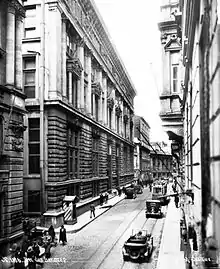
In the early decades of the Turkish Republic, the government (or banks established and owned by the government) had to subsidise most of the industrial projects, due to the lack of a strong private sector. However, in the period between the 1920s and 1950s, a new generation of Turkish entrepreneurs such as Nuri Demirağ, Vehbi Koç, Hacı Ömer Sabancı and Nejat Eczacıbaşı began to establish privately owned factories, some of which evolved into the largest industrial conglomerates that dominate the Turkish economy today, such as Koç Holding, Sabancı Holding and Eczacıbaşı Holding.
During the first six decades of the republic, between 1923 and 1983, Turkey generally adhered to a quasi-statist approach with strict government planning of the budget and government-imposed limitations over foreign trade, flow of foreign currency, foreign direct investment and private sector participation in certain fields (such as broadcasting, telecommunications, energy, mining, etc.). However, in 1983, Prime Minister Turgut Özal initiated a series of reforms designed to shift the economy from a statist, insulated system to a more private-sector, market-based model.[109]
The reforms, combined with unprecedented amounts of funding from foreign loans, spurred rapid economic growth; but this growth was punctuated by sharp recessions and financial crises in 1994, 1999 (following the earthquake in Izmit that year),[303] and 2001;[304] resulting in an average of 4 percent GDP growth per annum between 1981 and 2003.[305] Lack of additional fiscal reforms, combined with large and growing public sector deficits and widespread corruption, resulted in high inflation, a weak banking sector and increased macroeconomic volatility.[306] After the economic crisis of 2001 and the reforms initiated by the then finance minister, Kemal Derviş, inflation dropped to single-digit figures for the first time in decades (8% in 2005), investor confidence and foreign investment soared, and unemployment fell to 10% in 2005.[307] Turkey has gradually opened up its markets through economic reforms by reducing government controls on foreign trade and investment and the privatisation of publicly owned industries, and the liberalisation of many sectors to private and foreign participation has continued amid political debate.[308]
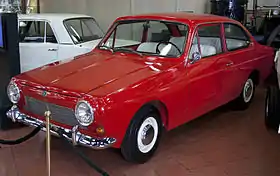
.jpg.webp)
The real GDP growth rate from 2002 to 2007 averaged 6.8 percent annually,[311] which made Turkey one of the fastest growing economies in the world during that period. However, growth slowed to 1 percent in 2008, and in 2009 the Turkish economy was affected by the global financial crisis, with a recession of 5 percent. According to Eurostat data, Turkish GDP per capita adjusted by purchasing power standards stood at 61 percent of the EU average in 2019.[312]
In the early years of the 21st century, the chronically high inflation was brought under control; this led to the launch of a new currency, the Turkish new lira (Yeni Türk Lirası) in 2005, to cement the acquisition of the economic reforms and erase the vestiges of an unstable economy.[313] In 2009, after only four years in circulation, the Turkish new lira was renamed back to the Turkish lira with the introduction of new banknotes and coins.
Tourism
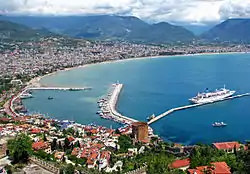
Tourism in Turkey has increased almost every year in the 21st century,[314] and is an important part of the economy. The Turkish Ministry of Culture and Tourism currently promotes Turkish tourism under the Turkey Home name. Turkey is one of the world's top ten destination countries, with the highest percentage of foreign visitors arriving from Germany and Russia in recent years.[314] In 2018 Turkey ranked 6th in the world in terms of the number of international tourist arrivals, with 45.8 million foreign tourists visiting the country.[315]
Turkey has 17 UNESCO World Heritage Sites, such as the "Historic Areas of Istanbul", the "Rock Sites of Cappadocia", the "Neolithic Site of Çatalhöyük", "Hattusa: the Hittite Capital", the "Archaeological Site of Troy", "Pergamon and its Multi-Layered Cultural Landscape", "Hierapolis – Pamukkale", and "Mount Nemrut";[316] and 51 World Heritage Sites in tentative list, such as the archaeological sites or historic urban centres of Göbekli Tepe, Gordion, Ephesus, Aphrodisias, Perga, Lycia, Sagalassos, Aizanoi, Zeugma, Ani, Harran, Mardin, Konya and Alanya.[317] Turkey is home to two of the Seven Wonders of the Ancient World, the world's oldest religious site Göbekli Tepe, and numerous other World Heritage Sites.[318][319][320]
Infrastructure
.jpg.webp)
In 2013 there were 98 airports in Turkey,[324] including 22 international airports.[325] İstanbul Airport is planned to be the largest airport in the world, with a capacity to serve 150 million passengers a year.[326][327] As well as Turkish Airlines, flag carrier of Turkey since 1933, several other airlines operate in the country.
As of 2014, the country has a roadway network of 65,623 kilometres (40,776 miles).[328] Turkish State Railways started building high-speed rail lines in 2003. The Ankara-Konya line became operational in 2011, while the Ankara-Istanbul line entered service in 2014.[329] Opened in 2013, the Marmaray tunnel under the Bosphorus connects the railway and metro lines of Istanbul's European and Asian sides; while the nearby Eurasia Tunnel (2016) provides an undersea road connection for motor vehicles.[330] The Bosphorus Bridge (1973), Fatih Sultan Mehmet Bridge (1988) and Yavuz Sultan Selim Bridge (2016) are the three suspension bridges connecting the European and Asian shores of the Bosphorus strait. The Osman Gazi Bridge (2016) connects the northern and southern shores of the Gulf of İzmit. The Çanakkale Bridge, currently under construction, will connect the European and Asian shores of the Dardanelles strait.
Many natural gas pipelines span the country's territory.[331] The Baku-Tbilisi-Ceyhan pipeline, the second longest oil pipeline in the world, was inaugurated in 2005.[332] The Blue Stream, a major trans-Black Sea gas pipeline, delivers natural gas from Russia to Turkey. The undersea pipeline, Turkish Stream, with an annual capacity around 63 billion cubic metres (2,200 billion cubic feet), allows Turkey to resell Russian gas to Europe.[333]
Turkey's internet, which has 42.3 million active users, holds a 'Not Free' ranking in Freedom House's index.[334] Turkish government has constantly blocked websites like Facebook, Twitter, YouTube and Wikipedia.[335] According to Twitter's transparency report, Turkey is the global leader in social media censorship.[336]
As of 2018 Turkey consumes 1700 terawatt hours (TW/h) of primary energy per year, a little over 20 megawatt hours (MW/h) per person, mostly from imported fossil fuels.[338] Although the energy policy of Turkey includes reducing fossil-fuel imports, coal in Turkey is the largest single reason why greenhouse gas emissions by Turkey amount to 1% of the global total. Renewable energy in Turkey is being increased and Akkuyu Nuclear Power Plant is being built on the Mediterranean coast: but despite national electricity generation overcapacity fossil fuels are still subsidized.[339] Turkey has the fifth-highest direct utilisation and capacity of geothermal power in the world.[340]
Water supply and sanitation in Turkey is characterised by achievements and challenges. Over the past decades access to drinking water has become almost universal and access to adequate sanitation has also increased substantially. Autonomous utilities have been created in the 16 metropolitan cities of Turkey and cost recovery has been increased, thus providing the basis for the sustainability of service provision. Intermittent supply, which was common in many cities, has become less frequent. Remaining challenges include the need to further increase wastewater treatment, to reduce the high level of non-revenue water hovering around 50% and to expand access to adequate sanitation in rural areas. The investment required to comply with EU standards in the sector, especially in wastewater treatment, is estimated to be in the order of €2 billion per year, more than double the current level of investment.[341]
Science and technology
.JPG.webp)
TÜBİTAK is the leading agency for developing science, technology and innovation policies in Turkey.[342] TÜBA is an autonomous scholarly society acting to promote scientific activities in Turkey.[343] TAEK is the official nuclear energy institution of Turkey. Its objectives include academic research in nuclear energy, and the development and implementation of peaceful nuclear tools.[344]
Turkish government companies for research and development in military technologies include Turkish Aerospace Industries, ASELSAN, HAVELSAN, ROKETSAN, MKE, among others. Turkish Satellite Assembly, Integration and Test Center (UMET) is a spacecraft production and testing facility owned by the Ministry of National Defence and operated by the Turkish Aerospace Industries (TAI). The Turkish Space Launch System (UFS) is a project to develop the satellite launch capability of Turkey. It consists of the construction of a spaceport, the development of satellite launch vehicles as well as the establishment of remote earth stations.[346][347][348] Türksat is the sole communications satellite operator in Turkey and has launched the Türksat series of satellites into orbit. Göktürk-1, Göktürk-2 and Göktürk-3 are Turkey's Earth observation satellites for reconnaissance, operated by the Turkish Ministry of National Defense. BILSAT-1 and RASAT are the scientific Earth observation satellites operated by the TÜBİTAK Space Technologies Research Institute.
In 2015, Aziz Sancar, a Turkish professor at the University of North Carolina, won the Nobel Chemistry Prize along with Tomas Lindahl and Paul Modrich, for their work on how cells repair damaged DNA.[349] Other Turkish scientists include physician Hulusi Behçet who discovered Behçet's disease and mathematician Cahit Arf who defined the Arf invariant.
Demographics
| Year | Pop. | ±% p.a. |
|---|---|---|
| 1927 | 13,554,000 | — |
| 1930 | 14,440,000 | +2.13% |
| 1940 | 17,728,000 | +2.07% |
| 1950 | 20,807,000 | +1.61% |
| 1960 | 27,506,000 | +2.83% |
| 1970 | 35,321,000 | +2.53% |
| 1980 | 44,439,000 | +2.32% |
| 1990 | 55,120,000 | +2.18% |
| 2000 | 64,252,000 | +1.54% |
| 2010 | 73,142,000 | +1.30% |
| 2019 | 82,579,000 | +1.36% |
| Source: Turkstat[350] | ||
According to the Address-Based Population Recording System of Turkey, the country's population was 74.7 million people in 2011,[351] nearly three-quarters of whom lived in towns and cities. According to the 2011 estimate, the population is increasing by 1.35 percent each year. Turkey has an average population density of 97 people per km². People within the 15–64 age group constitute 67.4 percent of the total population; the 0–14 age group corresponds to 25.3 percent; while senior citizens aged 65 years or older make up 7.3 percent.[352] In 1927, when the first official census was recorded in the Republic of Turkey, the population was 13.6 million.[353] The largest city in Turkey, Istanbul, is also the largest city in Europe by population, and the third-largest city in Europe in terms of size.[354][355]
Article 66 of the Turkish Constitution defines a "Turk" as "anyone who is bound to the Turkish state through the bond of citizenship"; therefore, the legal use of the term "Turkish" as a citizen of Turkey is different from the ethnic definition.[356] However, the majority of the Turkish population are of Turkish ethnicity and approximately 70–80 per cent of the country's citizens identify themselves as Turkish.[10][11] It is estimated that there are at least 47 ethnic groups represented in Turkey.[357] Reliable data on the ethnic mix of the population is not available, because Turkish census figures do not include statistics on ethnicity.[358]
Kurds are the largest non-Turkish ethnicity at anywhere from 12-25 per cent of the population.[360][361] The exact figure remains a subject of dispute; according to Servet Mutlu, "more often than not, these estimates reflect pro-Kurdish or pro-Turkish sympathies and attitudes rather than scientific facts or erudition".[357] Mutlu's 1990 study estimated Kurds made up around 12 per cent of the population, while Mehrdad Izady placed the figure around 25 per cent.[362] The Kurds are making up a majority in the provinces of Ağrı, Batman, Bingöl, Bitlis, Diyarbakır, Elâzığ, Hakkari, Iğdır, Mardin, Muş, Siirt, Şırnak, Tunceli and Van; a near majority in Şanlıurfa Province (47%); and a large minority in Kars Province (20%).[363] In addition, due to internal migration, Kurdish diaspora communities exist in all of the major cities in central and western Turkey. In Istanbul, there are an estimated three million Kurds, making it the city with the largest Kurdish population in the world.[364] Non-Kurdish minorities are believed to make up an estimated 7–12 percent of the population.[11]
| Region | Population |
|---|---|
| Marmara | 24,465,689 |
| Central Anatolia | 12,705,812 |
| Mediterranean | 10,552,942 |
| Aegean | 10,318,157 |
| Southeastern Anatolia | 8,876,531 |
| Black Sea | 7,674,496 |
| Eastern Anatolia | 5,966,101 |

The three "Non-Muslim" minority groups recognised in the Treaty of Lausanne were Armenians, Greeks and Jews. Other ethnic groups include Albanians, Arabs, Assyrians, Bosniaks, Circassians, Georgians, Laz, Pomaks, and Roma.[11][367][368][369][370] Turkey is also home to a Muslim community of Megleno-Romanians.[371] Minority groups other than the three religious minorities recognised in the Treaty of Lausanne (Armenians, Greeks and Jews) do not have any official rights, and use of the minority languages of Turkey is restricted.[372] The term "minority" itself remains a sensitive issue in Turkey, while the Turkish government is frequently criticised for its treatment of minorities.[372] Although minorities are not recognised, state-run Turkish Radio and Television Corporation (TRT) broadcasts television and radio programs in minority languages,[373][374] and minority language classes are available in some elementary schools.[375]
Before the start of the Syrian civil war in 2011, the estimated number of Arabs in Turkey varied from 1 million to more than 2 million.[376] As of April 2020, there are 3.6 million Syrian refugees in Turkey, who are mostly Arabs but also include Syrian Kurds, Syrian Turkmen, and other ethnic groups of Syria. The vast majority of these are living in Turkey with temporary residence permits. The Turkish government has granted Turkish citizenship to refugees who have joined the Syrian National Army.[377][378][379]
Immigration
Immigration to Turkey is the process by which people migrate to Turkey to reside in the country. Turkey's migrant crisis created after an estimated 2.5 percent of the population are international migrants.[381] Turkey hosts the largest number of refugees in the world, including 3.6 million Syrian refugees, as of April 2020.[377] As part of Turkey's migrant crisis, according to UNHCR, in 2018 Turkey was hosting 63.4% of all the refugees in the world, that is 3,564,919 registered refugees from Africa and the Middle East in total.[382]
Languages
The official language is Turkish, which is the most widely spoken Turkic language in the world.[383][384] It is spoken by 85.54 percent of the population as a first language.[385] 11.97 percent of the population speaks the Kurmanji dialect of Kurdish as their mother tongue.[385] Arabic and Zaza are the mother tongues of 2.39 percent of the population, and several other languages are the mother tongues of smaller parts of the population.[385] Endangered languages in Turkey include Abaza, Abkhaz, Adyghe, Cappadocian Greek, Gagauz, Hértevin, Homshetsma, Kabard-Cherkes, Ladino (Judesmo), Laz, Mlahso, Pontic Greek, Romani, Suret, Turoyo, Ubykh, and Western Armenian.[386] Megleno-Romanian is also spoken.[371]
Religion
Turkey is a secular state with no official state religion; the Turkish Constitution provides for freedom of religion and conscience.[391][392]
A 2016 survey by market research group Ipsos, interviewing 17,180 adults across 22 countries, found that Islam was the dominant religion in Turkey, adhered to by 82% of the total population; religiously unaffiliated people comprised 13% of the population, while 2% were Christians.[393] The CIA World Factbook reports that Islam is the religion of 99.8% of the population, with Sunni Muslims as the largest sect, while 0.2% are Christians and Jews.[394] However, there are no official governmental statistics specifying the religious beliefs of the Turkish people, nor is religious data recorded in the country's census.[395]
The role of religion in public life has been the source of debate since the Republic was established on a secular basis, and in recent years with the coming to prominence of Islamist parties.[396] For many decades, the wearing of the Hijab was banned in schools and government buildings because it was viewed as a symbol of political Islam. However, the ban was lifted from universities in 2011, from government buildings in 2013,[397] from schools in 2014[398] and from the Armed Forces in 2017.[399] The Justice and Development Party (AKP) government, in power since 2002, pursue an explicit policy of Islamization of education to "raise a devout generation" against secular resistance,[400][401] in the process causing lost jobs and educational opportunities for non-religious citizens of Turkey.[402] However, AKP policies have also caused an increase in interest and support for secularism in Turkey.[403][404]
Islam

After the dissolution of the Ottoman Empire, the number of Muslims in the region that became Turkey increased relative to that of the Christians with the immigration of Ottoman Muslims, who were facing extermination or other forms of repression in the newly constituted Balkan states. Not all were ethnic Turks; some were Muslim Albanians, Bosniaks, Greek Muslims, Muslim Serbs, Macedonian Muslims, Bulgarian Muslims[406] and Megleno-Romanian Muslims.[371] Other Turks and Circassians fleeing Russian expansion in areas such as the Caucasus and the Crimea also arrived during this period. By the 1920s, Islam had become the majority religion.[406]
The largest denomination is Sunni Islam, in accordance with the Hanafi school. There are also some Sufi Muslims.[407] Non-denominational Muslims have been estimated to range from 2%[408] to 14% of the population.[393]
The highest Islamic religious authority is the Presidency of Religious Affairs (Turkish: Diyanet İşleri Başkanlığı); it interprets the Hanafi school of law, and is responsible for regulating the operation of the country's 80,000 registered mosques and employing local and provincial imams.[409] Some have also complained that under the Islamist government of the Justice and Development Party (AKP) and Tayyip Erdoğan, the old role of the Diyanet – maintaining control over the religious sphere of Islam in Turkey – has "largely been turned on its head."[410] Now greatly increased in size, the Diyanet promotes a certain type of conservative (Hanafi Sunni) Islam inside Turkey, issuing fetva that disapprove of activities such as "feeding dogs at home, celebrating the western New Year, lotteries, and tattoos"[411] and projecting this "Turkish Islam" abroad.[410][412]
Academics suggest the Alevi population may be from 15 to 20 million, while the Alevi-Bektaşi Federation states that there are around 25 million.[413][414] According to Aksiyon magazine, the number of Twelver Shias (excluding Alevis) is three million (4.2%).[415] Under the government of the Justice and Development Party (AKP), discrimination against, and persecution of, the Alevi minority has increased.[416][417][418]
Christianity
.jpg.webp)
Christianity has a long history in present-day Turkey, which is the birthplace of numerous Christian apostles and saints, such as Paul of Tarsus, Timothy, Nicholas of Myra, Polycarp of Smyrna and many others. Saint Peter founded one of the first churches in Antioch (Antakya), the location of which is regarded by tradition as the spot where he first preached the Gospel, and where the followers of Jesus were called Christians for the first time. The house where Virgin Mary lived the final days of her life until her Assumption (according to Catholic doctrine) or Dormition (according to Orthodox belief),[419][420] and the tomb of John the Apostle, who accompanied her during the voyage to Anatolia after the crucifixion of Jesus, are in Ephesus. The cave churches in Cappadocia were among the hiding places of early Christians during the Roman persecutions against them. The Eastern Orthodox Church has been headquartered in Constantinople (Istanbul) since the First Council of Constantinople in 381 AD.[421][422] Two of the five major episcopal sees of the Pentarchy (Constantinople and Antioch) instituted by Justinian the Great in 531 AD[423] were located in present-day Turkey during the Byzantine period.[424]
The percentage of Christians in Turkey fell from 17.5% (three million followers) in a population of 16 million to 2.5% percent in the early 20th century.[425] The drop was the result of events that had a significant impact on the country's demographic structure, such as the Armenian Genocide, the population exchange between Greece and Turkey[426] and the emigration of Christians that began in the late 19th century and gained pace in the first quarter of the 20th century.[427] The 1942-44 wealth tax for non-Muslims, the emigration of a portion of Turkish Jews to Israel after 1948, and the ongoing Cyprus dispute, which damaged relations between Turkish Muslims and Christians (culminating in the Istanbul pogrom of 6–7 September 1955), were other important events that contributed to the decline of Turkey's non-Muslim population.
Today there are more than 120,000-320,000 people of various Christian denominations,[428] representing less than 0.2% of Turkey's population,[429] including an estimated 80,000 Oriental Orthodox, 35,000 Roman Catholics,[430] 18,000 Antiochian Greeks,[431] 5,000 Greek Orthodox and smaller numbers of Protestants.[432] Currently there are 236 churches open for worship in Turkey.[433]
Judaism
.JPG.webp)
The history of Judaism in Turkey dates back to the Romaniote Jews of Anatolia, who have been present since at least the 5th century BC. They built ancient places of worship such as the Sardis Synagogue in Lydia and the Priene Synagogue in Ionia. The Sephardi Jews, who were expelled from the Iberian peninsula and southern Italy under the control of the Spanish Empire, were welcomed into the Ottoman Empire between the late-15th and mid-16th centuries. Despite emigration during the 20th century, modern-day Turkey continues to have a small Jewish population.[434] At present, there are around 26,000 Jews in Turkey, the vast majority of whom are Sephardi.[435]
Irreligion

In a mid-2010s poll, 2.9% of Turkish respondents identified as atheists.[436] The Association of Atheism (Ateizm Derneği), the first official atheist organisation in the Balkans or Middle East, was founded in 2014.[437][438] Some religious and secular officials have claimed that atheism and deism are growing among Turkish people.[439][440][441][442]
Education
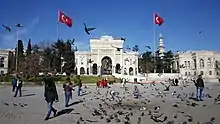
The Ministry of National Education is responsible for pre-tertiary education.[444] This is compulsory and lasts twelve years: four years each of primary school, middle school and high school.[445] Less than half of 25- to 34-year-old Turks have completed at least high school, compared with an OECD average of over 80 percent.[446] Basic education in Turkey is said to lag behind other OECD countries, with significant differences between high and low performers.[447] Turkey is ranked 32nd out of 34 in the OECD's PISA study.[445] Access to high-quality school heavily depends on the performance in the secondary school entrance exams, to the point that some students begin taking private tutoring classes when they are ten years old.[447] The overall adult literacy rate in 2011 was 94.1 percent; 97.9 percent for males and 90.3 percent for females.[448]
As of 2017, there are 190 universities in Turkey.[449] Except for the Open Education Faculties (AÖF) at Anadolu, Istanbul and Atatürk University; entrance is regulated by the national Student Selection and Placement System (ÖSYS) examination, after which high school graduates are assigned to universities according to their performance.[450] According to the 2012–2013 Times Higher Education World University Rankings, the top university in Turkey is Middle East Technical University, followed by Bilkent University and Koç University, Istanbul Technical University and Boğaziçi University.[451] All state and private universities are under the control of the Higher Education Board (YÖK), whose head is appointed by the President of Turkey; and since 2016 the President directly appoints all rectors of all state and private universities.[452] Turkey is a member of the European Higher Education Area and actively participates in the Bologna Process.[453]
In 2016 the Skills Matter survey conducted by OECD found the levels of numeracy and literacy in the adult population of Turkey at rank 30 of the 33 OECD countries surveyed. [454]
In 2017 the theory of evolution was removed from the national curriculum of high schools, while the concept of jihad was added as a new subject.[455]
Health

The Ministry of Health has run a universal public healthcare system since 2003.[456] Known as Universal Health Insurance Genel Sağlık Sigortası, it is funded by a tax surcharge on employers, currently at 5%.[456] Public-sector funding covers approximately 75.2% of health expenditures.[456]
Despite the universal health care, total expenditure on health as a share of GDP in 2018 was the lowest among OECD countries at 6.3% of GDP, compared to the OECD average of 9.3%.[456]
Average life expectancy is 78.6 years (75.9 for males and 81.3 for females), compared with the EU average of 81 years.[456] Turkey has one of the highest rates of obesity in the world, with nearly one third (29.5%) of its adult population obese. Air pollution in Turkey is a major cause of early death.[457]
Culture
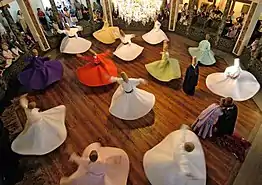
Turkey has a very diverse culture that is a blend of various elements of the Turkic, Anatolian, Ottoman (which was itself a continuation of both Greco-Roman and Islamic cultures) and Western culture and traditions, which started with the Westernisation of the Ottoman Empire and still continues today.[459][460] This mix originally began as a result of the encounter of Turks and their culture with those of the peoples who were in their path during their migration from Central Asia to the West.[459][461] Turkish culture is a product of efforts to be a "modern" Western state, while maintaining traditional religious and historical values.[459]
Visual arts
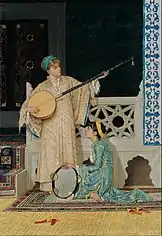
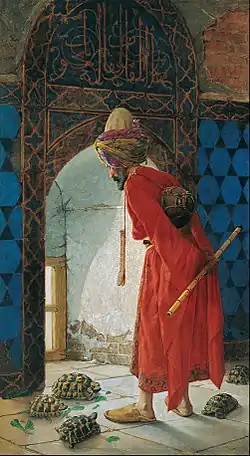
Turkish painting, in the Western sense, developed actively starting from the mid 19th century. The first painting lessons were scheduled at what is now the Istanbul Technical University (then the Imperial Military Engineering School) in 1793, mostly for technical purposes.[462] In the late 19th century, human figure in the Western sense was being established in Turkish painting, especially with Osman Hamdi Bey. Impressionism, among the contemporary trends, appeared later on with Halil Pasha. The young Turkish artists sent to Europe in 1926 came back inspired by contemporary trends such as Fauvism, Cubism and even Expressionism, still very influential in Europe. The later "Group D" of artists led by Abidin Dino, Cemal Tollu, Fikret Mualla, Fahrünnisa Zeid, Bedri Rahmi Eyüboğlu, Adnan Çoker and Burhan Doğançay introduced some trends that had lasted in the West for more than three decades. Other important movements in Turkish painting were the "Yeniler Grubu" (The Newcomers Group) of the late 1930s; the "On'lar Grubu" (Group of Ten) of the 1940s; the "Yeni Dal Grubu" (New Branch Group) of the 1950s; and the "Siyah Kalem Grubu" (Black Pen Group) of the 1960s.[463]
Carpet weaving is a traditional art from pre-Islamic times. During its long history, the art and craft of the woven carpet has integrated different cultural traditions. Traces of Byzantine design can be detected; Turkic peoples migrating from Central Asia, as well as Armenian people, Caucasian and Kurdish tribes either living in, or migrating to Anatolia, brought with them their traditional designs. The arrival of Islam and the development of Islamic art also influenced Turkish carpet design. The history of its designs, motifs and ornaments thus reflects the political and ethnic history and diversity of Asia minor. However, scientific attempts were unsuccessful, as yet, to attribute a particular design to a specific ethnic, regional, or even nomadic versus village tradition.[464]

Ottoman miniature is linked to the Persian miniature tradition, as well as strong Chinese artistic influences. The words tasvir or nakış were used to define the art of miniature painting in Ottoman Turkish. The studios the artists worked in were called nakkaşhane.[465] The miniatures were usually not signed, perhaps because of the rejection of individualism, but also because the works were not created entirely by one person; the head painter designed the composition of the scene, and his apprentices drew the contours (which were called tahrir) with black or colored ink and then painted the miniature without creating an illusion of depth. The head painter, and much more often the scribe of the text, were indeed named and depicted in some of the manuscripts. The understanding of perspective was different from that of the nearby European Renaissance painting tradition, and the scene depicted often included different time periods and spaces in one picture. They followed closely the context of the book they were included in, more illustrations than standalone works of art.[466]
The earliest examples of Turkish paper marbling, called ebru in Turkish, are said to be a copy of the Hâlnâme by the poet Arifî. The text of this manuscript was rendered in a delicate cut paper découpage calligraphy by Mehmed bin Gazanfer and completed in 1540, and features many marbled and decorative paper borders. One early master by the pseudonym of Şebek is mentioned posthumously in the earliest Ottoman text on the art known as the Tertib-i Risâle-i Ebrî, which is dated based on internal evidence to after 1615. The instructions for several ebru techniques in the text are accredited to this master. Another famous 18th-century master by the name of Hatip Mehmed Efendi (died 1773) is accredited with developing motifs and perhaps early floral designs, although evidence from India appears to contradict some of these reports. Despite this, marbled motifs are commonly referred to as hatip designs in Turkey today.[467]

Literature and theatre
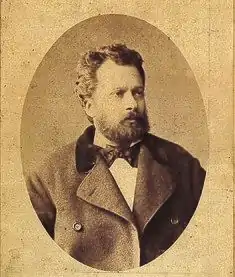
Turkish literature is a mix of cultural influences. Interaction between the Ottoman Empire and the Islamic world along with Europe contributed to a blend of Turkic, Islamic and European traditions in modern-day Turkish music and literary arts.[470] Turkish literature was heavily influenced by Persian and Arabic literature during most of the Ottoman era. The Tanzimat reforms introduced previously unknown Western genres, primarily the novel and the short story. Many of the writers in the Tanzimat period wrote in several genres simultaneously: for instance, the poet Nâmık Kemal also wrote the important 1876 novel İntibâh (Awakening), while the journalist Şinasi has written, in 1860, the first modern Turkish play, the one-act comedy "Şair Evlenmesi" (The Poet's Marriage). Most of the roots of modern Turkish literature were formed between the years 1896 and 1923. Broadly, there were three primary literary movements during this period: the Edebiyat-ı Cedîde (New Literature) movement; the Fecr-i Âtî (Dawn of the Future) movement; and the Millî Edebiyat (National Literature) movement. The first radical step of innovation in 20th century Turkish poetry was taken by Nâzım Hikmet, who introduced the free verse style. Another revolution in Turkish poetry came about in 1941 with the Garip movement led by Orhan Veli, Oktay Rıfat and Melih Cevdet. The mix of cultural influences in Turkey is dramatised, for example, in the form of the "new symbols of the clash and interlacing of cultures" enacted in the novels of Orhan Pamuk, recipient of the 2006 Nobel Prize in Literature.[471]
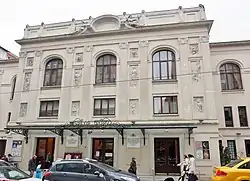
The origin of Turkish theatre dates back to ancient pagan rituals and oral legends. The dances, music and songs performed during the rituals of the inhabitants of Anatolia millennia ago are the elements from which the first shows originated. In time, the ancient rituals, myths, legends and stories evolved into theatrical shows. Starting from the 11th-century, the traditions of the Seljuk Turks blended with those of the indigenous peoples of Anatolia and the interaction between diverse cultures paved the way for new plays. After the Tanzimat (Reformation) period in the 19th century, characters in Turkish theatre were modernised and plays were performed on European-style stages, with actors wearing European costumes. Following the restoration of constitutional monarchy with the Young Turk Revolution in 1908, theatrical activities increased and social problems began to be reflected at the theatre as well as in historical plays. A theatrical conservatoire, Darülbedayi-i Osmani (which became the nucleus of the Istanbul City Theatres) was established in 1914. During the years of chaos and war, the Darülbedayi-i Osmani continued its activities and attracted the younger generation. Numerous Turkish playwrights emerged in this era; some of them wrote on romantic subjects, while others were interested in social problems, and still others dealt with nationalistic themes. The first Turkish musicals were also written in this period. In time, Turkish women began to appear on stage, which was an important development in the late Ottoman society. Until then, female roles had only been played by actresses who were members of Turkey's ethnic minorities. Today there are numerous private theatres in the country, together with those which are subsidised by the government, such as the Turkish State Theatres.[472] Notable players, directors and playwrights of Turkish theatre include Muhsin Ertuğrul, Haldun Taner, Aziz Nesin, Gülriz Sururi, Yıldız Kenter, Müşfik Kenter, Haldun Dormen, Sadri Alışık, Çolpan İlhan, Münir Özkul, Adile Naşit, Erol Günaydın, Gazanfer Özcan, Nejat Uygur, Genco Erkal, Metin Serezli, Nevra Serezli, Levent Kırca, Zeki Alasya, Metin Akpınar, Müjdat Gezen, Ferhan Şensoy, among others.
Music and dance
Music of Turkey includes mainly Turkic elements as well as partial influences ranging from Central Asian folk music, Arabic music, Greek music, Ottoman music, Persian music and Balkan music, as well as references to more modern European and American popular music. The roots of traditional music in Turkey span across centuries to a time when the Seljuk Turks migrated to Anatolia and Persia in the 11th century and contains elements of both Turkic and pre-Turkic influences. Much of its modern popular music can trace its roots to the emergence in the early 1930s drive for Westernization.[473]

With the assimilation of immigrants from various regions the diversity of musical genres and musical instrumentation also expanded. Turkey has also seen documented folk music and recorded popular music produced in the ethnic styles of Greek, Armenian, Albanian, Polish and Jewish communities, among others.[474]
Many Turkish cities and towns have vibrant local music scenes which, in turn, support a number of regional musical styles. Despite this however, western music styles like pop music and kanto lost popularity to arabesque in the late 1970s and 1980s. It became popular again by the beginning of the 1990s, as a result of an opening economy and society. With the support of Sezen Aksu, the resurging popularity of pop music gave rise to several international Turkish pop stars such as Tarkan and Sertab Erener. The late 1990s also saw an emergence of underground music producing alternative Turkish rock, electronica, hip-hop, rap and dance music in opposition to the mainstream corporate pop and arabesque genres, which many believe have become too commercial.[475] Internationally acclaimed Turkish jazz and blues musicians and composers include Ahmet Ertegun (founder and president of Atlantic Records), Nükhet Ruacan and Kerem Görsev.
The Turkish Five (Turkish: Türk Beşleri) is a name used by some authors to identify the five pioneers of Western classical music in Turkey, namely Ahmed Adnan Saygun, Ulvi Cemal Erkin, Cemal Reşit Rey, Hasan Ferit Alnar and Necil Kazım Akses.[476] Internationally acclaimed Turkish musicians of Western classical music include pianists İdil Biret, Verda Erman, Gülsin Onay, the Pekinel sisters (Güher and Süher Pekinel), Ayşegül Sarıca and Fazıl Say; violinists Ayla Erduran and Suna Kan; opera singers Semiha Berksoy, Leyla Gencer and Güneş Gürle; and conductors Emre Aracı, Gürer Aykal, Erol Erdinç, Rengim Gökmen and Hikmet Şimşek.
Turkish folk dance is diverse. Hora is performed in East Thrace; Zeybek in the Aegean Region, Southern Marmara and East-Central Anatolia Region; Teke in the Western Mediterranean Region; Kaşık Oyunları and Karşılama in West-Central Anatolia, Western Black Sea Region, Southern Marmara Region and Eastern Mediterranean Region; Horon in the Central and Eastern Black Sea Region; Halay in Eastern Anatolia and the Central Anatolia Region; and Bar and Lezginka in the Northeastern Anatolia Region.[477]
Architecture
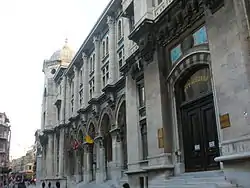

The architecture of the Seljuk Turks combined the elements and characteristics of the Turkic architecture of Central Asia with those of Persian, Arab, Armenian and Byzantine architecture. The transition from Seljuk architecture to Ottoman architecture is most visible in Bursa, which was the capital of the Ottoman State between 1335 and 1413. Following the Ottoman conquest of Constantinople (Istanbul) in 1453, Ottoman architecture was significantly influenced by Byzantine architecture. Topkapı Palace in Istanbul is one of the most famous examples of classical Ottoman architecture and was the primary residence of the Ottoman Sultans for approximately 400 years.[478] Mimar Sinan (c.1489–1588) was the most important architect of the classical period in Ottoman architecture. He was the chief architect of at least 374 buildings which were constructed in various provinces of the Ottoman Empire in the 16th century.[479]
Since the 18th century, Turkish architecture has been increasingly influenced by European styles, and this can be particularly seen in the Tanzimat era buildings of Istanbul like the Dolmabahçe, Çırağan, Feriye, Beylerbeyi, Küçüksu, Ihlamur and Yıldız palaces, which were all designed by members of the Balyan family of Ottoman Armenian court architects.[480] The Ottoman era waterfront houses (yalı) on the Bosphorus also reflect the fusion between classical Ottoman and European architectural styles during the aforementioned period.
The First National Architectural Movement (Birinci Ulusal Mimarlık Akımı) in the early 20th century sought to create a new architecture, which was based on motifs from Seljuk and Ottoman architecture. The movement was also labelled Turkish Neoclassical or the National Architectural Renaissance.[481] The leading architects of this movement were Vedat Tek (1873–1942), Mimar Kemaleddin Bey (1870–1927), Arif Hikmet Koyunoğlu (1888–1982) and Giulio Mongeri (1873–1953).[482] Buildings from this era are the Grand Post Office in Istanbul (1905–1909), Tayyare Apartments (1919–1922),[483] Istanbul 4th Vakıf Han (1911–1926),[484] State Art and Sculpture Museum (1927–1930),[485] Ethnography Museum of Ankara (1925–1928),[486] the first Ziraat Bank headquarters in Ankara (1925–1929),[487] the first Türkiye İş Bankası headquarters in Ankara (1926–1929),[488] Bebek Mosque,[489] and Kamer Hatun Mosque.[490][491]
Cuisine

Turkish cuisine is largely the heritage of Ottoman cuisine. In the early years of the Republic, a few studies were published about regional Anatolian dishes but cuisine did not feature heavily in Turkish folkloric studies until the 1980s, when the fledgling tourism industry encouraged the Turkish state to sponsor two food symposia. The papers submitted at the symposia presented the history of Turkish cuisine on a "historical continuum" that dated back to Turkic origins in Central Asia and continued through the Seljuk and Ottoman periods.[494]
Many of the papers presented at these first two symposia were unreferenced. Prior to the symposia, the study of Turkish culinary culture was first popularised by the publication of Süheyl Ünver's Fifty Dishes in Turkish History in 1948. This book was based on recipes found in an 18th century Ottoman manuscript. His second book was about palace cuisine during the reign of Mehmet II. Following the publication of Ünver's book subsequent studies were published, including a 1978 study by a historian named Bahaettin Ögel about the Central Asian origins of Turkish cuisine.[494]
Ottoman cuisine contains elements of Turkish, Byzantine, Balkan, Armenian, Kurdish, Arab and Persian cuisines.[495] The country's position between Europe, Asia and the Mediterranean Sea helped the Turks in gaining complete control of the major trade routes, and an ideal landscape and climate allowed plants and animals to flourish. Turkish cuisine was well established by the mid-1400s, the beginning of the Ottoman Empire's six hundred-year reign. Yogurt salads, fish in olive oil, sherbet and stuffed and wrapped vegetables became Turkish staples. The empire, eventually spanning from Austria and Ukraine to Arabia and North Africa, used its land and water routes to import exotic ingredients from all over the world. By the end of the 16th century, the Ottoman court housed over 1,400 live-in cooks and passed laws regulating the freshness of food. Since the fall of the empire in World War I (1914–1918) and the establishment of the Turkish Republic in 1923, foreign food such as French hollandaise sauce and Western fast food have made their way into the modern Turkish diet.[496]
Sports

The most popular sport in Turkey is association football.[497] Galatasaray won the UEFA Cup and UEFA Super Cup in 2000.[498] The Turkish national football team has won the bronze medal at the 2002 FIFA World Cup, the 2003 FIFA Confederations Cup and UEFA Euro 2008.[499]
Other mainstream sports such as basketball and volleyball are also popular. The men's national basketball team won the silver medal at the 2010 FIBA World Championship and at the EuroBasket 2001, which were both hosted by Turkey; and is one of the most successful at the Mediterranean Games. Turkish basketball club Fenerbahçe played the Final of the EuroLeague in three consecutive seasons (2016, 2017 and 2018), becoming the European champions in 2017 and runners-up in 2016 and 2018. Another Turkish basketball club, Anadolu Efes S.K. won the 1995–96 FIBA Korać Cup, were the runners-up of the 2018–19 EuroLeague and the 1992–93 FIBA Saporta Cup, and finished third at the 1999–2000 EuroLeague and the 2000–01 SuproLeague.[500][501] Beşiktaş won the 2011–12 FIBA EuroChallenge,[502] and Galatasaray won the 2015–16 Eurocup. The Final of the 2013–14 EuroLeague Women basketball championship was played between two Turkish teams, Galatasaray and Fenerbahçe, and won by Galatasaray.[503] The women's national basketball team won the silver medal at the EuroBasket Women 2011 and the bronze medal at the EuroBasket Women 2013. Like the men's team, the women's basketball team is one of the most successful at the Mediterranean Games.

The women's national volleyball team won the gold medal at the 2015 European Games, the silver medal at the 2003 European Championship, the bronze medal at the 2011 European Championship, and the bronze medal at the 2012 FIVB World Grand Prix. They also won multiple medals over multiple decades at the Mediterranean Games.[505] Women's volleyball clubs, namely Fenerbahçe, Eczacıbaşı and Vakıfbank, have won numerous European championship titles and medals. Fenerbahçe won the 2010 FIVB Women's Club World Championship and the 2012 CEV Women's Champions League. Representing Europe as the winner of the 2012–13 CEV Women's Champions League, Vakıfbank also became the world champion by winning the 2013 FIVB Volleyball Women's Club World Championship. Recently Vakıfbank has won the 2017 FIVB Volleyball Women's Club World Championship[506][507][508] and the 2017–18 CEV Women's Champions League for the fourth time in their history.[509]
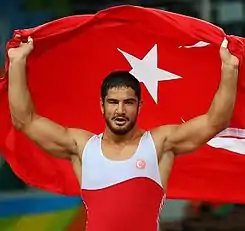
The traditional national sport of Turkey has been yağlı güreş (oil wrestling) since Ottoman times.[510] Edirne Province has hosted the annual Kırkpınar oil wrestling tournament since 1361, making it the oldest continuously held sporting competition in the world.[511][512] In the 19th and early 20th centuries, Ottoman Turkish oil wrestling champions such as Koca Yusuf, Nurullah Hasan and Kızılcıklı Mahmut acquired international fame in Europe and North America by winning world heavyweight wrestling championship titles. International wrestling styles governed by FILA such as freestyle wrestling and Greco-Roman wrestling are also popular, with many European, World and Olympic championship titles won by Turkish wrestlers both individually and as a national team.[513] Renowned Turkish freestyle and Greco-Roman wrestlers who won international competitions include Yaşar Doğu, Celal Atik, Mahmut Atalay, Hamza Yerlikaya, Rıza Kayaalp and Taha Akgül.
Media and cinema
Hundreds of television channels, thousands of local and national radio stations, several dozen newspapers, a productive and profitable national cinema and a rapid growth of broadband Internet use constitute a vibrant media industry in Turkey.[515] The majority of the TV audiences are shared among public broadcaster TRT and the network-style channels such as Kanal D, Show TV, ATV and Star TV. The broadcast media have a very high penetration as satellite dishes and cable systems are widely available.[516] The Radio and Television Supreme Council (RTÜK) is the government body overseeing the broadcast media.[516][517] By circulation, the most popular newspapers are Posta, Hürriyet, Sözcü, Sabah and Habertürk.[518]
Turkish television dramas are increasingly becoming popular beyond Turkey's borders and are among the country's most vital exports, both in terms of profit and public relations.[519] After sweeping the Middle East's television market over the past decade, Turkish shows have aired in more than a dozen South and Central American countries in 2016.[520] Turkey is today the world's second largest exporter of television series.[521]
Yeşilçam is the sobriquet that refers to the Turkish film art and industry. The first movie exhibited in the Ottoman Empire was the Lumiere Brothers' 1895 film, L'Arrivée d'un train en gare de La Ciotat, which was shown in Istanbul in 1896. The first Turkish-made film was a documentary entitled Ayastefanos'taki Rus Abidesinin Yıkılışı (Demolition of the Russian Monument at San Stefano), directed by Fuat Uzkınay and completed in 1914. The first narrative film, Sedat Simavi's The Spy, was released in 1917. Turkey's first sound film was shown in 1931. Turkish directors like Nuri Bilge Ceylan, Yılmaz Güney and Ferzan Özpetek won numerous international awards such as the Palme d'Or and Golden Bear.[522]
Despite legal provisions, media freedom in Turkey has steadily deteriorated from 2010 onwards, with a precipitous decline following the failed coup attempt on 15 July 2016.[523] As of December 2016, at least 81 journalists were imprisoned in Turkey and more than 100 news outlets were closed.[245] Freedom House lists Turkey's media as not free.[247] The media crackdowns also extend to Internet censorship with Wikipedia getting blocked between 29 April 2017 and 15 January 2020.[524][525]
Notes
- Turkish President Recep Tayyip Erdogan has said "Our attitude on the Armenian issue has been clear from the beginning. We will never accept the accusations of genocide".[21] Scholars give several reasons for Turkey's position including the preservation of national identity, the demand for reparations and territorial concerns.[22]
References
- "Türkiye Cumhuriyeti Anayasası" (in Turkish). Grand National Assembly of Turkey. Archived from the original on 1 July 2020. Retrieved 1 July 2020.
3. Madde: Devletin Bütünlüğü, Resmi Dili, Bayrağı, Milli Marşı ve Başkenti: Türkiye Devleti, ülkesi ve milletiyle bölünmez bir bütündür. Dili Türkçedir. Bayrağı, şekli kanununda belirtilen, beyaz ay yıldızlı al bayraktır. Milli marşı "İstiklal Marşı" dır. Başkenti Ankara'dır.
- "Mevzuat: Anayasa" (in Turkish). Ankara: Constitutional Court of Turkey. Archived from the original on 1 July 2020. Retrieved 1 July 2020.
- Ethnologue: Ethnologue Languages of the World – Turkey, Retrieved 15 October 2017.
- "The effective date of the Turkish Constitution is November 9, 1982".
- "Surface water and surface water change". Organisation for Economic Co-operation and Development (OECD). Retrieved 11 October 2020.
- "The Results of Address Based Population Registration System, 2020". Turkish Statistical Institute. 31 December 2020. Retrieved 5 February 2021.
- "World Economic Outlook Database, October 2020". IMF.org. International Monetary Fund. Retrieved 17 October 2020.
- "Gini coefficient of equivalised disposable income - EU-SILC survey". ec.europa.eu/eurostat. Eurostat. Retrieved 13 February 2020.
- "2020 Human Development Report" (PDF). United Nations Development Programme. 2020. Retrieved 15 December 2020.
- "Toplumsal Yapı Araştırması 2006" (PDF). KONDA Research and Consultancy. 2006. Archived from the original (PDF) on 15 February 2017. Retrieved 21 February 2015.
- "Turkey". The World Factbook. Central Intelligence Agency]]. Retrieved 13 October 2016.
- Howard, Douglas Arthur (2001). The History of Turkey. Greenwood Publishing Group. p. 43. ISBN 978-0-313-30708-9.
- Sharon R. Steadman; Gregory McMahon (2011). The Oxford Handbook of Ancient Anatolia: (10,000–323 BC). Oxford University Press. pp. 3–11, 37. ISBN 978-0-19-537614-2. Retrieved 23 March 2013.
- Casson, Lionel (1977). "The Thracians" (PDF). The Metropolitan Museum of Art Bulletin. 35 (1): 2–6. doi:10.2307/3258667. JSTOR 3258667.
- David Noel Freedman; Allen C. Myers; Astrid Biles Beck (2000). Eerdmans Dictionary of the Bible. Wm. B. Eerdmans Publishing. p. 61. ISBN 978-0-8028-2400-4. Retrieved 24 March 2013.
- Mehmet Fuat Köprülü&Gary Leiser. The origins of the Ottoman Empire. p. 33.
- Masters, Bruce (2013). The Arabs of the Ottoman Empire, 1516–1918: A Social and Cultural History. Cambridge University Press. ISBN 978-1-107-03363-4.
- Somel, Selcuk Aksin (2010). The A to Z of the Ottoman Empire. Scarecrow Press. ISBN 978-1-4617-3176-4.
- Marushiakova, Elena; Popov, Veselin Zakhariev; Popov, Veselin; Descartes), Centre de recherches tsiganes (Université René (2001). Gypsies in the Ottoman Empire: A Contribution to the History of the Balkans. Univ of Hertfordshire Press. ISBN 978-1-902806-02-0.
- Roderic. H. Davison, Essays in Ottoman and Turkish History, 1774-1923 – The Impact of West, Texas 1990, pp. 115-116.
- "Erdogan: Turkey will 'never accept' genocide charges". Deutsche Welle. Retrieved 7 February 2018.
- Tatz, Colin; Higgins, Winton (2016). The Magnitude of Genocide. ABC-CLIO. ISBN 978-1-4408-3161-4.
- Schaller, Dominik J.; Zimmerer, Jürgen (2008). "Late Ottoman genocides: the dissolution of the Ottoman Empire and Young Turkish population and extermination policies—introduction". Journal of Genocide Research. 10 (1): 7–14. doi:10.1080/14623520801950820. ISSN 1462-3528. S2CID 71515470.
- Roderic H. Davison; Review "From Paris to Sèvres: The Partition of the Ottoman Empire at the Peace Conference of 1919–1920" by Paul C. Helmreich in Slavic Review, Vol. 34, No. 1 (March 1975), pp. 186–187
- "The Political Economy of Regional Power: Turkey" (PDF). giga-hamburg.de. Retrieved 18 February 2015.
- M.B (4 November 1939). "The Political and Strategic Importance of Turkey". Bulletin of International News. 16 (22): 3–11. JSTOR 25642612.
- "European Parliament votes to suspend Turkey's EU membership bid". www.dw.com. Deutsche Welle. 13 March 2019. Retrieved 19 April 2020.
- Michael J. Arlen (2006). Passage to Ararat. MacMillan. p. 159. ISBN 978-0-374-53012-9.
- "Turkey". Oxford English Dictionary (Online ed.). Oxford University Press. (Subscription or participating institution membership required.)
- "The World's First Temple". Archaeology magazine. November–December 2008. p. 23.
- "Hattusha: the Hittite Capital". whc.unesco.org. Retrieved 12 June 2014.
- "The Position of Anatolian" (PDF). Archived from the original (PDF) on 5 May 2013. Retrieved 4 May 2013.
- Balter, Michael (27 February 2004). "Search for the Indo-Europeans: Were Kurgan horsemen or Anatolian farmers responsible for creating and spreading the world's most far-flung language family?". Science. 303 (5662): 1323. doi:10.1126/science.303.5662.1323. PMID 14988549. S2CID 28212584.
- "Çatalhöyük added to UNESCO World Heritage List". Global Heritage Fund. 3 July 2012. Archived from the original on 17 January 2013. Retrieved 9 February 2013.
- "Troy". ancient.eu. Retrieved 9 August 2014.
- "Ziyaret Tepe – Turkey Archaeological Dig Site". uakron.edu. Retrieved 4 September 2010.
- "Assyrian Identity in Ancient Times And Today'" (PDF). Retrieved 4 September 2010.
- Zimansky, Paul. Urartian Material Culture As State Assemblage: An Anomaly in the Archaeology of Empire. p. 103.
- The Metropolitan Museum of Art, New York (October 2000). "Anatolia and the Caucasus, 2000–1000 B.C. in Timeline of Art History.". New York: The Metropolitan Museum of Art. Archived from the original on 10 September 2006. Retrieved 21 December 2006.
- Roux, Georges. Ancient Iraq. p. 314.
- "The Mausoleum of Halicarnassus: A Wonder of the Ancient World". ancient-origins.net. 19 May 2015.
- Mark Cartwright. "Celsus Library". Ancient.eu. Retrieved 2 February 2017.
- "The Temple of Artemis at Ephesus: The Un-Greek Temple and Wonder". ancient.eu. Retrieved 17 February 2017.
- D.M. Lewis; John Boardman (1994). The Cambridge Ancient History. Cambridge University Press. p. 444. ISBN 978-0-521-23348-4. Retrieved 7 April 2013.
- Joseph Roisman, Ian Worthington. "A companion to Ancient Macedonia" John Wiley & Sons, 2011. ISBN 1-4443-5163-X pp. 135–138, 343
- Hooker, Richard (6 June 1999). "Ancient Greece: The Persian Wars". Washington State University, Washington, United States. Archived from the original on 20 November 2010. Retrieved 22 December 2006.
- The Metropolitan Museum of Art, New York (October 2000). "Anatolia and the Caucasus (Asia Minor), 1000 B.C. – 1 A.D. in Timeline of Art History.". New York: The Metropolitan Museum of Art. Archived from the original on 14 December 2006. Retrieved 21 December 2006.
- Theo van den Hout (2011). The Elements of Hittite. Cambridge University Press. p. 1. ISBN 978-1-139-50178-1. Retrieved 24 March 2013.
- "Hagia Sophia". Encyclopædia Britannica. Retrieved 2 February 2017.
- "Acts 11:26 and when he found him, he brought him back to Antioch. So for a full year they met together with the church and taught large numbers of people. The disciples were first called Christians at Antioch". biblehub.com.
- Encyclopaedia Biblica, Vol. I, p. 186 (p. 125 of 612 in online .pdf file).
- Daniel C. Waugh (2004). "Constantinople/Istanbul". University of Washington, Seattle, Washington. Retrieved 26 December 2006.
- Maas, Michael (2015). The Cambridge Companion to the Age of Attila. Cambridge University Press. ISBN 978-1-107-02175-4.
- Wink, Andre (1990). Al Hind: The Making of the Indo Islamic World, Vol. 1, Early Medieval India and the Expansion of Islam, 7th–11th Centuries. Brill Academic Publishers. p. 21. ISBN 978-90-04-09249-5.
- "The Seljuk Turks". peter.mackenzie.org. Retrieved 9 August 2014.
- Davison, Roderic H. (2013). Essays in Ottoman and Turkish History, 1774–1923: The Impact of the West. University of Texas Press. pp. 3–5. ISBN 978-0-292-75894-0.
- Katherine Swynford Lambton, Ann; Lewis, Bernard, eds. (1977). The Cambridge history of Islam (Reprint. ed.). Cambridge [u.a.]: Cambridge Univ. Press. p. 233. ISBN 978-0-521-29135-4.
- Craig S. Davis. "The Middle East For Dummies" ISBN 0-7645-5483-2 p. 66
- Thomas Spencer Baynes. "The Encyclopædia Britannica: Latest Edition. A Dictionary of Arts, Sciences and General Literature, Volume 23". Werner, 1902
- Emine Fetvacı. "Picturing History at the Ottoman Court" p 18
- Simons, Marlise (22 August 1993). "Center of Ottoman Power". The New York Times. Retrieved 4 June 2009.
- "Dolmabahce Palace". dolmabahcepalace.com. Retrieved 4 August 2014.
- Faroqhi, Suraiya (1994). "Crisis and Change, 1590–1699". In İnalcık, Halil; Donald Quataert (eds.). An Economic and Social History of the Ottoman Empire, 1300–1914. 2. Cambridge University Press. p. 507. ISBN 978-0-521-57456-3.
- Stanford J. Shaw (1976). History of the Ottoman Empire and Modern Turkey. 1. Cambridge University Press. p. 213. ISBN 978-0-521-29163-7. Retrieved 15 June 2013.
- Kirk, George E. (2008). A Short History of the Middle East. Brill Academic Publishers. p. 58. ISBN 978-1-4437-2568-2.
- Palabiyik, Hamit, Turkish Public Administration: From Tradition to the Modern Age, (Ankara, 2008), 84.
- Ismail Hakki Goksoy. Ottoman-Aceh Relations According to the Turkish Sources (PDF). Archived from the original (PDF) on 19 January 2008. Retrieved 7 December 2018.
- Charles A. Truxillo (2012), Jain Publishing Company, "Crusaders in the Far East: The Moro Wars in the Philippines in the Context of the Ibero-Islamic World War".
- "Ottoman/Turkish Visions of the Nation, 1860–1950". Retrieved 18 February 2015.
- Niall Ferguson (2 January 2008). "An Ottoman warning for indebted America". Financial Times. Retrieved 5 September 2016.
- Todorova, Maria (2009). Imagining the Balkans. Oxford University Press. p. 175. ISBN 978-0-19-972838-1. Retrieved 15 June 2013.
- Mann, Michael (2005). The Dark Side of Democracy: Explaining Ethnic Cleansing. Cambridge University Press. p. 118. ISBN 978-0-521-53854-1. Retrieved 28 February 2013.
- "Collapse of the Ottoman Empire, 1918–1920". nzhistory.net.nz. Retrieved 9 August 2014.
- "Why Turkey hasn't forgotten about the First World War". britishcouncil.org. Retrieved 1 February 2017.
- Isa Blumi (2013). Ottoman Refugees, 1878-1939: Migration in a Post-Imperial World. Bloomsbury Academic. ISBN 978-1-4725-1536-0.
- "Armenian Genocide". Encyclopædia Britannica. Retrieved 23 April 2015.
- "Fact Sheet: Armenian Genocide". University of Michigan. Archived from the original on 21 November 2010. Retrieved 15 July 2010.
- Freedman, Jeri (2009). The Armenian genocide (1st ed.). New York: Rosen Pub. Group. ISBN 978-1-4042-1825-3.
- Totten, Samuel, Paul Robert Bartrop, Steven L. Jacobs (eds.) Dictionary of Genocide. Greenwood Publishing Group, 2008, p. 19. ISBN 0-313-34642-9.
- Raziye Akkoç (15 October 2015). "ECHR: Why Turkey won't talk about the Armenian genocide". The Daily Telegraph. Retrieved 28 May 2016.
- Donald Bloxham (2005). The Great Game of Genocide: Imperialism, Nationalism, And the Destruction of the Ottoman Armenians. Oxford University Press. p. 150. ISBN 978-0-19-927356-0. Retrieved 9 February 2013.
- Levene, Mark (Winter 1998). "Creating a Modern 'Zone of Genocide': The Impact of Nation- and State-Formation on Eastern Anatolia, 1878–1923". Holocaust and Genocide Studies. 12 (3): 393–433. doi:10.1093/hgs/12.3.393.
- Ferguson, Niall (2007). The War of the World: Twentieth-Century Conflict and the Descent of the West. Penguin Group. p. 180. ISBN 978-0-14-311239-6.
- "The Treaty of Sèvres, 1920". Harold B. Library, Brigham Young University.
- Mango, Andrew (2000). Atatürk: The Biography of the Founder of Modern Turkey. Overlook. p. lxxviii. ISBN 978-1-58567-011-6.
- Heper, Criss, Metin, Nur Bilge (2009). Historical Dictionary of Turkey. Scarecrow Press. ISBN 978-0-8108-6281-4.
- Axiarlis, Evangelia (2014). Political Islam and the Secular State in Turkey: Democracy, Reform and the Justice and Development Party. I.B. Tauris. p. 11.
- Clogg, Richard (2002). A Concise History of Greece. Cambridge University Press. p. 101. ISBN 978-0-521-00479-4. Retrieved 9 February 2013.
- "Turkey holds first election that allows women to vote". OUPblog. 6 February 2012.
- Gerhard Bowering; Patricia Crone; Wadad Kadi; Devin J. Stewart; Muhammad Qasim Zaman; Mahan Mirza (2012). The Princeton Encyclopedia of Islamic Political Thought. Princeton University Press. p. 49. ISBN 978-1-4008-3855-4. Retrieved 14 August 2013.
Following the revolution, Mustafa Kemal became an important figure in the military ranks of the Ottoman Committee of Union and Progress (CUP) as a protégé ... Although the sultanate had already been abolished in November 1922, the republic was founded in October 1923. ... ambitious reform programme aimed at the creation of a modern, secular state and the construction of a new identity for its citizens.
- League of Nations Treaty Series, vol. 173, pp. 214–241.
- Hassan, Mona (10 January 2017). Longing for the Lost Caliphate: A Transregional History. Princeton University Press. ISBN 978-1-4008-8371-4.
- Soner Çağaptay (2002). "Reconfiguring the Turkish nation in the 1930s". Nationalism and Ethnic Politics, 8:2. Yale University. 8 (2): 67–82. doi:10.1080/13537110208428662. S2CID 143855822.
- "Growth in United Nations membership (1945–2005)". United Nations. 3 July 2006. Archived from the original on 17 January 2016. Retrieved 30 October 2006.
- "Members and partners". OECD. Retrieved 9 August 2014.
- Hale, William Mathew (1994). Turkish Politics and the Military. Routledge. pp. 161, 215, 246. ISBN 978-0-415-02455-6.
- Arsu, Sebsem (12 April 2012). "Turkish Military Leaders Held for Role in '97 Coup". The New York Times. Retrieved 11 August 2014.
- Uslu, Nasuh (2003). The Cyprus question as an issue of Turkish foreign policy and Turkish-American relations, 1959–2003. Nova Publishers. p. 119. ISBN 978-1-59033-847-6. Retrieved 16 August 2011.
- "Timeline: Cyprus". BBC. 12 December 2006. Retrieved 25 December 2006.
- "UN Cyprus Talks". United Nations. Retrieved 1 February 2017.
- "U.S. Department of State - Bureau of Counterterrorism: Foreign Terrorist Organizations". U.S. Department of State. Retrieved 18 April 2020.
- "Council of the European Union: Council Decision (CFSP) 2019/1341 of 8 August 2019 updating the list of persons, groups and entities subject to Articles 2, 3 and 4 of Common Position 2001/931/CFSP on the application of specific measures to combat terrorism". Official Journal of the European Union. Retrieved 18 April 2020.
- "PKK". Republic of Turkey: Ministry of Foreign Affairs. Retrieved 19 April 2020.
- Timeline: Kurdish militant group PKK's three-decade war with Turkey, Reuters, 21 March 2013
- Reuters (10 January 2016). "Turkish forces kill 32 Kurdish militants in bloody weekend as conflict escalates". The Guardian.
- "Turkey's PKK peace plan delayed". BBC. 10 November 2009. Retrieved 6 February 2010.
- "Ocalan sentenced to death". BBC. 29 June 1999.
- "Turkey lifts Ocalan death sentence". BBC. 3 October 2002.
- Nas, Tevfik F. (1992). Economics and Politics of Turkish Liberalization. Lehigh University Press. p. 12. ISBN 978-0-934223-19-5.
- "Chronology of Turkey-EU relations". Turkish Secretariat of European Union Affairs. Archived from the original on 15 May 2007. Retrieved 30 October 2006.
- "Interview with European Commission President Jose Manuel Barroso on BBC Sunday AM" (PDF). European Commission. 15 October 2006. Archived (PDF) from the original on 21 November 2006. Retrieved 17 December 2006.
- Mullen, Jethro; Cullinane, Susannah (4 June 2013). "What's driving unrest and protests in Turkey?". CNN. Retrieved 6 June 2013.
- Cunningham, Erin; Sly, Liz; Karatas, Zeynep (16 July 2016). "Turkey rounds up thousands of suspected participants in coup attempt". The Washington Post. Retrieved 17 July 2016.
- Hansen, Suzy (13 April 2017). "Inside Turkey's Purge". The New York Times. Retrieved 6 May 2017.
- "Turkey Purge". turkeypurge.com. Retrieved 6 May 2017.
- "Pence heads to Turkey as Erdogan rejects calls for ceasefire in Syria". Deutsche Welle. 16 October 2019.
- "Full Text: Memorandum of Understanding between Turkey and Russia on northern Syria". The Defense Post. 22 October 2019.
- "Turkey not resuming military operation in northeast Syria: security source". Reuters. 25 November 2019 – via www.reuters.com.
- "General Structure of Turkish Public Administration" (PDF). justice.gov.tr/. Ministry of Justice. Archived from the original (PDF) on 21 March 2015. Retrieved 14 August 2014.
- "Ministry of Internal Affairs: Administrative Units in Turkey". Retrieved 17 April 2020.
- Ulaş BAYRAKTAR; Élise MASSICARD (July 2012). "Decentralisation in Turkey" (PDF). Agence française de développement.
- Charlotte Joppien (24 September 2014). "'Civic Participation' or 'Customer Satisfaction'? Waves of Centralization, Decentralization and Recentralization from the Ottoman Empire until Today". ResearchTurkey. Archived from the original on 19 October 2017. Retrieved 14 December 2016.
- "The Turkish Constitution and the Kurdish Question". The Carnegie Endowment for International Peace. 1 August 2011.
- Soner Cagaptay (3 August 2015). "Turkey's Kurdish Moment". The Washington Institute.
- Stefano Sarsale (1 December 2016). "HDP arrests pose grave risks for Turkey's future". Global Risk Insights.
- Aylin Güney; Ayşe Aslihan Çelenk (2010). "Europeanization and the dilemma of decentralization: centre–local relations in Turkey" (PDF). Journal of Balkan and Near Eastern Studies.
- "Local and regional democracy in Turkey". Council of Europe, Congress of Local and Regional Authorities, Monitoring Committee. 1 March 2011.
- "BDP's decentralization proposal debated in Turkey". Hurriyet Daily News. 3 October 2010.
- "The principle of decentralization in the new constitution". Hurriyet Daily News. 24 September 2010.
- "Recep Tayyip the First: Erdogan inaugurates a new political era in Turkey". The Economist. 28 June 2018.
- Chris Morris (22 June 2018). "Turkey elections: How powerful will the next Turkish president be?". BBC News. BBC.
- Turkish Directorate General of Press and Information (17 October 2001). "Turkish Constitution". Turkish Prime Minister's Office. Archived from the original on 3 February 2007. Retrieved 16 December 2006.
- "Euro court backs Turkey Islamist ban". BBC. 31 July 2001. Retrieved 14 December 2006.
- "Turkey's Kurd party ban criticised". BBC. 14 March 2003. Retrieved 14 December 2006.
- Turkish Directorate General of Press and Information (24 August 2004). "Political Structure of Turkey". Turkish Prime Minister's Office. Archived from the original on 3 February 2007. Retrieved 14 December 2006.
- Kate Fleet; Suraiya Faroqhi; Reşat Kasaba (2008). The Cambridge History of Turkey. Cambridge University Press. pp. 357–358. ISBN 978-0-521-62096-3. Retrieved 13 June 2013.
- Çarkoğlu, Ali (2004). Religion and Politics in Turkey. Routledge. ISBN 978-0-415-34831-7.
- "Turkey quickly sliding into authoritarian rule after move to increase Erdogan's powers". The Independent. 30 December 2016. Retrieved 9 January 2017.
- Chan, Sewell (9 January 2017). "Turkey's Parliament Starts Debate on Expansion of President's Powers". The New York Times. Retrieved 9 January 2017.
- Dombey, Daniel. "Turkey's Erdogan lurches toward authoritarianism". Financial Times. Retrieved 10 January 2017.
- Board, The Editorial (1 November 2016). "Can Turkey's Democracy Survive President Erdogan?". The New York Times. Retrieved 10 January 2017.
- Braun, Stefan (28 February 2017). "Europarat sieht Türkei auf dem Weg in die Autokratie". Sueddeutsche.de (in German). Süddeutsche Zeitung. Retrieved 3 March 2017.
- "EU: Bericht: Europarat sieht Türkei auf dem Weg in die Autokratie". Die Zeit. 1 March 2017. Archived from the original on 4 March 2017. Retrieved 3 March 2017.
- "Türkei: Europarat warnt vor drohender Autokratie" (in German). Tagesschau. Retrieved 3 March 2017.
- "The Latest: Turkey releases official referendum results". Washington Post. Retrieved 2 May 2017.
- "Turkey referendum: Erdogan declares victory". CNN. Retrieved 2 May 2017.
- "Turkish constitutional referendum: TRexit from parliamentary democracy?". euronews.com. Retrieved 14 March 2017.
- "Turkey constitutional changes: what are they, how did they come about and how are they different?". independent.co.uk. 21 January 2017. Retrieved 28 March 2017.
- "Democracy Index 2017: Revenge of the "deplorables"". eiu.com. The Economist Intelligence Unit. 25 January 2017. Retrieved 20 July 2017.
- "Turkey". freedomhouse.org. 5 January 2018.
- The Economist Intelligence Unit (8 January 2019). "Democracy Index 2018: Me Too?". The Economist Intelligence Unit. Retrieved 13 January 2019.
- "Turkish Legal System". mymerhaba.com/. Archived from the original on 22 September 2014. Retrieved 14 August 2014.
- "The Judicial System of Turkey" (PDF). uhdigm.adalet.gov.tr/. Ministry of Justice. Archived from the original (PDF) on 3 March 2016. Retrieved 14 August 2014.
- "General Directorate of Judicial Records". adlisicil.adalet.gov. Retrieved 25 November 2016.
- "European Commission: Turkey 2015 report" (PDF). European Commission. 10 November 2015. Archived from the original (PDF) on 18 August 2016. Retrieved 6 July 2016.
- "European Parliament resolution of 14 April 2016 on the 2015 report on Turkey". European Parliament. 14 April 2016. Retrieved 6 July 2016.
- "Turkey's institutions are failing to comply with good governance principles and combat corruption". Transparency International. 7 April 2016. Retrieved 6 July 2016.
- "As ISIS attacks mount, Turkey steps up its war on free speech". Newsweek. 6 July 2016. Retrieved 6 July 2016.
- "The United Nations Organization and Turkey". mfa.gov.tr. Archived from the original on 15 July 2014. Retrieved 12 June 2014.
- "Turkey's Relations with the Organisation for Economic Co-operation and Development (OECD)". mfa.gov.tr. Archived from the original on 15 July 2014. Retrieved 12 June 2014.
- "The Republic of Turkey and The Organization of The Islamic Conference". mfa.gov.tr. Archived from the original on 14 July 2014. Retrieved 12 June 2014.
- "The Organization for Security and Co-operation in Europe (OSCE)". mfa.gov.tr. Archived from the original on 15 July 2014. Retrieved 12 June 2014.
- "Turkey's relations with the Economic Cooperation Organization (ECO)". mfa.gov.tr. Archived from the original on 16 May 2014. Retrieved 12 June 2014.
- "The Black Sea Economic Cooperation Organization (BSEC)". mfa.gov.tr. Archived from the original on 15 July 2014. Retrieved 12 June 2014.
- "D8". mfa.gov.tr. Archived from the original on 15 July 2014. Retrieved 12 June 2014.
- "G-20". mfa.gov.tr. Archived from the original on 15 July 2014. Retrieved 12 June 2014.
- "Türkiye'nin üyeliği kabul edildi". Hürriyet Daily News. 17 October 2008. Retrieved 1 November 2010.
- "SCO accepts Afghanistan as observer, Turkey dialogue partner". Xinhua. 7 June 2012. Retrieved 7 June 2012.
- "No: 253, 26 September 2013, Press Release on Turkey's Membership to the Asia Cooperation Dialogue". Ministry of Foreign Affairs of Turkey. 26 September 2013. Retrieved 26 October 2013.
- Mardell, Mark (11 December 2006). "Turkey's EU membership bid stalls". BBC. Retrieved 17 December 2006.
- "False Friends. Why the United States Is Getting Tough With Turkey". Foreign Affairs. 20 February 2014. Retrieved 6 April 2015.
- "Turkey: Background and U.S. Relations" (PDF). fas.org. Retrieved 6 April 2015.
- Huston, James A. (1988). Outposts and Allies: U.S. Army Logistics in the Cold War, 1945–1953. Susquehanna University Press. p. 134. ISBN 978-0-941664-84-4.
- Ziya Öniş, ŞuhnazYılmaz. "Turkey-EU-US Triangle in Perspective: Transformation or Continuity?" (PDF). istanbul2004.ku.edu.tr/. Archived from the original (PDF) on 16 March 2014. Retrieved 4 August 2014.
- Mitrovic, Marija (24 March 2014). Turkish Foreign Policy towards the Balkans (PDF). edoc.hu-berlin.de. Humboldt-Universität zu Berlin, Philosophische Fakultät III, Institut für Sozialwissenschaften. Retrieved 9 August 2014.
- "Turkey's Relations with NATO". mfa.gov.tr. Archived from the original on 22 October 2014. Retrieved 12 June 2014.
- İdris Bal (2004). Turkish Foreign Policy in Post Cold War Era. Universal-Publishers. p. 269. ISBN 978-1-58112-423-1. Retrieved 15 June 2013.
- Elanchenny, Susae (2010). Breaking the Ice The Role of Civil Society and Media in Turkey-Armenia Relations An Evaluation of the 'Dialogue-Building between Turkey and Armenia' Project. Istanbul: Istanbul Kültür University. p. 9. ISBN 978-605-4233-80-9.
- Taşpınar, Ömer (September 2008). "Turkey's Middle East Policies: Between Neo-Ottomanism and Kemalism". Carnegie Endowment for International Peace. Retrieved 5 June 2010.
- Murinson, Alexander (2009). Turkey's Entente with Israel and Azerbaijan: State Identity and Security in the Middle East and Caucasus (Routledge Studies in Middle Eastern Politics). Routledge. p. 119. ISBN 978-0-415-77892-3.
- "Syria ratchets up tension with Turkey – warning it of dangers of rebel support". Euronews. 4 October 2013.
- "Turkey, Egypt recall envoys in wake of violence". Bloomberg. 16 August 2013. Archived from the original on 28 September 2013.
- Yaşar Yakış (29 September 2014). "On Relations between Turkey and Egypt". Turkish Weekly. Archived from the original on 5 October 2014. Retrieved 19 November 2014.
- "Israel and Turkey end rift over Gaza flotilla killings". BBC News. BBC. 27 June 2016. Retrieved 27 June 2016.
- "Greece, Egypt, Cyprus urge Turkey to quit gas search off island". Reuters. 29 October 2014. Retrieved 19 November 2014.
- "Egypt, Greece, Cyprus pledge to boost energy cooperation". Reuters. 8 November 2014. Retrieved 19 November 2014.
- "Policy of Zero Problems with our Neighbors". Turkish Ministry of Foreign Affairs. Archived from the original on 22 October 2014. Retrieved 19 November 2014.
- Piotr Zalewsky (22 August 2013). "How Turkey Went From 'Zero Problems' to Zero Friends". Foreign Policy. Retrieved 19 November 2014.
- Mark Lowen (20 November 2014). "Erdogan's 'New Turkey' drifts towards isolation". BBC News. BBC. Retrieved 22 November 2014.
- Gareth Porter (28 May 2015). "Gulf allies and 'Army of Conquest'". Al-Ahram Weekly.
- "Syria conflict: Turkey and Russia 'agree ceasefire plan'". BBC News. BBC. 28 December 2016.
- "Turkey and Russia agree on draft Syria ceasefire, report says". CNN. 28 December 2016.
- "How Russia and Turkey brokered peace in Syria – and sidelined the US". CNN. 30 December 2016.
- "Kurdish fighters join Turkey's Afrin operation". Al-Monitor. 16 February 2018.
- "Recep Tayyip Erdogan vows to 'drown' Syrian Kurdish force set up by US". The Independent. 15 January 2018.
- "Turkey to U.S.: End support for Syrian Kurd YPG or risk confrontation". Reuters. 25 January 2018.
- "Will The Egyptian And Turkish Militaries Clash In Libya?". Forbes. 9 July 2020.
- "Cyprus: EU 'appeasement' of Turkey in exploration row will go nowhere". Reuters. 17 August 2020.
- "Turkey threatens Greece over disputed Mediterranean territorial claims". Deutsche Welle. 5 September 2020.
- Turkish General Staff (2006). "Turkish Armed Forces Defense Organization". Turkish Armed Forces. Archived from the original on 18 February 2009. Retrieved 15 December 2006.
- Anıl Şahin (14 February 2019). "Deniz Kuvvetlerinden TCG Trakya açıklaması". SavunmaSanayiST.com.
- Ahmet Doğan (9 November 2019). "TCG Trakya ne zaman bitecek?". DenizHaber.com.
- United Nations High Commissioner for Refugees (UNHCR), Directorate for Movements of Persons, Migration and Consular Affairs – Asylum and Migration Division (July 2001). "Turkey/Military service" (PDF). UNHCR. Archived from the original (PDF) on 22 November 2006. Retrieved 27 December 2006.CS1 maint: multiple names: authors list (link)
- "EBCO: European Bureau for Conscientious Objection". Ebco-beoc.eu. Retrieved 4 September 2010.
- "Financial and Economic Data Relating to NATO Defence" (PDF). NATO. 13 April 2012. Retrieved 16 June 2013.
- "Der Spiegel: Foreign Minister Wants US Nukes out of Germany (10 April 2009)". Der Spiegel. 30 March 2009. Retrieved 1 November 2010.
- Hans M. Kristensen. "NRDC: U.S. Nuclear Weapons in Europe" (PDF). Natural Resources Defense Council, 2005. Archived from the original (PDF) on 1 January 2011. Retrieved 1 November 2010.
- "Enter the EU Battle Groups" (PDF). Chaillot Paper no.97. European Union Institute for Security Studies. February 2007. p. 88.
- "Contribution of Turkish Armed Forces to Peace Support Operations". tsk.tr. Turkish Armed Forces. Archived from the original on 19 February 2015. Retrieved 3 August 2014.
- Richmond, Oliver P. (1998). Mediating in Cyprus: The Cypriot Communities and the United Nations. Psychology Press. p. 260. ISBN 978-0-7146-4877-4. Retrieved 9 February 2013.
- "Turkey finalizes military training base in Somalia". hurriyetdailynews.com. Retrieved 5 April 2017.
- "Turkey trains Kurdish peshmerga forces in fight against Islamic State". Reuters. 22 November 2014. Retrieved 5 April 2017.
- Larrabee, F. Stephen; Lesser, Ian O. (2003). Turkish foreign policy in an age of uncertainty. Santa Monica: Rand Corporation. pp. 94. ISBN 978-0-8330-3404-5.
albania.
- "What is Turkey doing in Iraq?". Hürriyet Daily News. 8 October 2016.
- "Seeing shared threats, Turkey sets up military base in Qatar". Reuters. 28 April 2016.
- "Turkey to open its largest military base in Somalia". TRT World. 30 September 2017.
- "The World's Most And Least Peaceful Countries in 2016". forbes.com. Retrieved 5 April 2017.
- "European Court of Human Rights: Turkey Ranks First in Violations in between 1959–2011". Bianet – Bagimsiz Iletisim Agi. Retrieved 29 December 2015.
- "Annual report" (PDF) (The European Court of Human Rights). 2014. Retrieved 29 December 2015. Cite journal requires
|journal=(help) - "Human rights in Turkey: still a long way to go to meet accession criteria". European Parliament Human Rights committee. 26 October 2010. Retrieved 9 February 2013.
- Zürcher, Erik J. (2004). Turkey A Modern History, Revised Edition. I.B.Tauris. p. 263. ISBN 978-1-85043-399-6.
- "Lice'nin Fis köyünde PKK'nın kuruluşunu kutladılar". Hürriyet Daily News. 27 November 2014. Retrieved 2 July 2015.
- Bilgin, Fevzi; Sarihan, Ali, eds. (2013). Understanding Turkey's Kurdish Question. Lexington Books. p. 90. ISBN 978-0-7391-8403-5.
- Balci, Ali (2016). The PKK-Kurdistan Workers' Party's Regional Politics: During and After the Cold War. Springer. p. 96. ISBN 978-3-319-42219-0.
- White, Paul (2015). The PKK: Coming Down from the Mountains. Zed Books Ltd. ISBN 978-1-78360-040-3. Retrieved 24 July 2017.
- Stanton, Jessica A. (2016). Violence and Restraint in Civil War: Civilian Targeting in the Shadow of International Law. Cambridge University Press. p. 217. ISBN 978-1-107-06910-7. Retrieved 24 July 2017.
- France-Presse, Agence (2 February 2016). "Turkish lecturer to be put on trial for posing exam question on PKK leader". The Guardian. Retrieved 24 July 2017.
- "Ever closer to independence". The Economist. Retrieved 24 July 2017.
- Eder, Mine (2016). "Turkey". In Lust, Ellen (ed.). The Middle East (14 ed.). CQ Press. ISBN 978-1-5063-2930-7.
The Turkish military responded with a ferocious counterinsurgency campaign that led to the deaths of nearly 40,000 people, most of them Turkish Kurdish civilians, and the displacement of more than three million Kurds from southeastern Turkey.
- "The European Court of Human Rights: Case of Benzer and others v. Turkey" (PDF) (Procedure). 24 March 2014: 3. Cite journal requires
|journal=(help) - "The prohibition of torture" (PDF) (Torturing). 2003: 11, 13. Retrieved 29 December 2015. Cite journal requires
|journal=(help) - Human Rights Watch. Human Rights Watch. 1998. p. 7.
- McKiernan, Kevin (2006). The Kurds: A People in Search of Their Homeland (1st ed.). New York: St. Martin's Press. p. 130. ISBN 978-0-312-32546-6.
- Neuberger, Benyamin (2014). Bengio, Ofra (ed.). Kurdish Awakening: Nation Building in a Fragmented Homeland. [S.l.]: Univ of Texas Press. p. 27. ISBN 978-0-292-75813-1.
- Gunes, Cengiz; Zeydanlioğlu, Welat (2014). The Kurdish question in Turkey : new perspectives on violence, representation, and reconciliation. Hoboken, NJ: Taylor and Francis. p. 98. ISBN 978-1-135-14063-2.
- "Police arrest and assistance of a lawyer" (PDF). Cite journal requires
|journal=(help) - "Justice Comes from European Court for a Kurdish Journalist". Retrieved 1 January 2016.
- "Turkish parliament moves to strip lawmakers' immunity from prosecution". Deutsche Welle. 20 May 2016.
- "Turkey orders 70 army officers detained over Gulen links – CNN Turk". Reuters. 29 March 2018.
- "Turkey arrests German for spreading Kurdish propaganda: Anadolu". Reuters. 25 July 2018.
- "Erdogan Renews Putsch Purge With Targets in Media, Academia". Bloomberg. 31 October 2016.
- "From soldiers to midwives, Turkey dismisses 15,000 more after coup bid". Reuters. 24 November 2016.
- "Turkish court orders release of journalists during their trial". Reuters. 9 March 2018.
- Turkey's Press Freedom Crisis. "Turkey's Press Freedom Crisis". Committee to Protect Journalists. Retrieved 9 February 2013.
- "Turkey's crackdown propels number of journalists in jail worldwide to record high". cpj.org. Retrieved 17 January 2017.
- "Russia, China and Turkey top yearly list of music freedom violations". freemuse.org. Archived from the original on 19 February 2015. Retrieved 19 February 2015.
- "Turkey". freedomhouse.org. Retrieved 29 January 2015.
- "Rights violations, terror ops threaten Turkey's democratic institutions: PACE". Hurriyet Daily News. 23 June 2016. Retrieved 23 June 2016.
- Trew, Bel (18 October 2019). "Turkey faces scrutiny over alleged use of chemical weapons on children in Syria". The Independent.
- Haddad, Tareq (18 October 2019). "Turkey accused of war crimes after suspected white phosphorus use against civilian Kurds in Syria". Newsweek.
- "Chemical weapons watchdog: Turkey did not use white phosphorus in Syria". TRT World. 7 November 2019.
- "Damning evidence of war crimes by Turkish forces and allies in Syria". Amnesty International. 18 October 2019.
- Vinokurov, E.; Libman, A. (15 December 2012). Eurasian Integration: Challenges of Transcontinental Regionalism. Springer. ISBN 978-1-137-28335-1.
- Immerfall, Stefan (2009). Handbook of European Societies: Social Transformations in the 21st Century. Springer. p. 417. ISBN 978-0-387-88198-0. Retrieved 9 August 2011.
- Metz, Helen Chapin, ed. (1996). "Geography". Turkey: A Country Study. Area handbook series (fifth ed.). Washington, DC: US GPO for the Federal Research Division of the Library of Congress. ISBN 978-0-8444-0864-4. LCCN 95049612.
- US Library of Congress. "Geography of Turkey". US Library of Congress. Retrieved 13 December 2006.
- "UN Demographic Yearbook" (PDF). Retrieved 1 November 2010.
- "Geography of Turkey". Turkish Ministry of Tourism. 2005. Retrieved 13 December 2006.
- "Lake Van". britannica.com. Retrieved 18 February 2015.
- "Armenian Highland – Historic Region". Encyclopedia Britannica. Retrieved 28 November 2018.
Armenian Highland, mountainous region of western Asia. It lies mainly in Turkey, occupies all of Armenia, and includes southern Georgia, western Azerbaijan, and northwestern Iran.
- "Mount Ararat". britannica.com. Retrieved 18 February 2015.
- "Biodiversity in Turkey". 6 May 2012. Archived from the original on 7 April 2016. Retrieved 9 August 2014.
- "Turkey's flora and fauna". allaboutturkey.com. Retrieved 12 June 2014.
- Couzens, Dominic (2008). Top 100 Birding Sites of the World. University of California Press. pp. 73–75. ISBN 978-0-520-25932-4.
- "Pontic Mountains and highlands". Archived from the original on 26 February 2014. Retrieved 9 August 2014.
- Blunt, Wilfrid. Tulipomania. p. 7.
- E.S. Forster (trans. et ed.), The Turkish Letters of Ogier Ghiselin de Busbecq (Oxford, 1927).
- "Statistics". milliparklar.gov.tr. Ministry of Forest and Water – General Directorare of Nature Conservation and National Parks. Retrieved 12 June 2014.
- Can, O.E. (2004). Status, conservation and management of large carnivores in Turkey. Convention on the Conservation of European Wildlife and Natural Habitats. Standing Committee, 24th meeting, 29 November-3 December 2004, Strasbourg.
- "Diyarbakır'da öldürülen leopar İran Parsı çıktı". Archived from the original on 23 October 2016. Retrieved 21 July 2015.
- Üstay, A.H. (1990). Hunting in Turkey. BBA, Istanbul.
- Kazancı, Nizamettin; Kuzucuoğlu, Catherine (2019), Kuzucuoğlu, Catherine; Çiner, Attila; Kazancı, Nizamettin (eds.), "Threats and Conservation of Landscapes in Turkey", Landscapes and Landforms of Turkey, World Geomorphological Landscapes, Springer International Publishing, pp. 603–632, doi:10.1007/978-3-030-03515-0_36, ISBN 978-3-030-03515-0
- "Specific Animals of Turkey". gateofturkey.com. Retrieved 12 June 2014.
- Grantham, H. S.; et al. (2020). "Anthropogenic modification of forests means only 40% of remaining forests have high ecosystem integrity - Supplementary Material". Nature Communications. 11 (1): 5978. doi:10.1038/s41467-020-19493-3. ISSN 2041-1723. PMC 7723057. PMID 33293507.
- "Climate of Turkey" (PDF). General Directorate of Meteorology. Archived from the original (PDF) on 28 March 2014. Retrieved 24 January 2014.
- "World Economic Outlook Database, October 2019". IMF.org. International Monetary Fund. Retrieved 24 May 2020.
- "World Economic Outlook Database, April 2020". IMF.org. International Monetary Fund. Retrieved 24 May 2020.
- "Gross Domestic Product 2018, PPP. (Last revised on 23 December 2019.)" (PDF). The World Bank: World Development Indicators Database. Retrieved 22 April 2020.
- "Gross Domestic Product 2018, Nominal. (Last revised on 23 December 2019.)" (PDF). The World Bank: World Development Indicators Database. Retrieved 22 April 2020.
- Bartolomiej Kaminski; Francis Ng (1 May 2006). "Turkey's evolving trade integration into Pan-European markets" (PDF). World Bank. p. 3. Archived from the original (PDF) on 14 June 2007. Retrieved 27 December 2006.
- "2015 Production Statistics". Organisation Internationale des Constructeurs d'Automobiles. Retrieved 31 August 2016.
- "The Shipbuilding Industry in Turkey" (PDF). OECD. September 2011.
- "About Best-Selling Home Appliance Brand Beko UK". Retrieved 9 August 2014.
- "Beko Avrupa'da üçüncülüğe oynuyor". Retrieved 9 August 2014.
- "The Unknown TV Giant – Businessweek". Retrieved 9 August 2014.
- "Panoramic view of the modern skyline of Istanbul's European side, with the skyscrapers of Levent at the center and the Bosphorus Bridge (1973) at right". Retrieved 2 December 2020.
- "View of the skyscrapers in Levent from Sporcular Park". Retrieved 2 December 2020.
- "Istanbul remains motoring power of Turkey's economy". hurriyetdailynews.com. Retrieved 13 June 2014.
- "Turkey: Agriculture and Rural Development" (PDF). Retrieved 9 December 2011.
- Turkish Statistical Institute (27 February 2006). "The result of Income Distribution". Turkish Statistical Institute. Archived from the original on 14 October 2006. Retrieved 11 December 2006.
- "No woman, no growth". Hürriyet Daily News. Retrieved 8 June 2013.
- "Religious Women in Turkey Have Been Left Out of Emancipation Movement". The New York Times. 23 May 2013. Retrieved 8 June 2013.
- "M&A Encumbered Risks Damping Hot Money Bond Party: Turkey Credit". Bloomberg L.P. 18 February 2013. Archived from the original on 5 November 2013. Retrieved 8 June 2013.
- "How to ruin a country's economy: AKP's 15 year long order of plunder and depredation in Turkey". BirGün. 6 December 2016. Retrieved 7 December 2016.
- "Turkey's external debt stock reaches $453.2B". Anadolu Agency. 30 March 2018.
- "Turkey's current account deficit at $5.4 billion in April". Hürriyet Daily News. 11 June 2018.
- "WIND VS COAL POWER IN TURKEY/SOLAR PV VS COAL IN TURKEY" (PDF). Carbon Tracker. 2020.
- Ambrose, Jillian (12 March 2020). "Coronavirus poses threat to climate action, says watchdog". The Guardian. ISSN 0261-3077. Retrieved 13 March 2020.
- Acar, Sevil; Challe, Sarah; Christopoulos, Stamatios; Christo, Giovanna (2018). "Fossil fuel subsidies as a lose-lose: Fiscal and environmental burdens in Turkey". New Perspectives on Turkey. 58: 93–124. doi:10.1017/npt.2018.7.
- "Energy pricing and non-market flows in Turkey's energy sector" (PDF). SHURA Energy Transition Center.
- "Big nations aid fossil fuels more than clean energies amid pandemic, researchers find". Climate Home News. 3 July 2020. Retrieved 7 July 2020.
- "The EBRD's just transition initiative". European Bank for Reconstruction and Development.
- "Turkish quake hits shaky economy". BBC. 17 August 1999. Retrieved 12 December 2006.
- "'Worst over' for Turkey". BBC. 4 February 2002. Retrieved 12 December 2006.
- "Turkey Labor Market Study" (PDF). World Bank. 2005. Retrieved 10 December 2006.
- OECD (14 November 2002). Turkey 2002: Crucial Support for Economic Recovery. OECD Publishing. p. 23. ISBN 978-92-64-17601-0. Retrieved 15 June 2013.
- "Data and Statistics for Turkey". World Bank. 2005. Archived from the original on 30 November 2006. Retrieved 10 December 2006.
- Madslien, Jorn (2 November 2006). "Robust economy raises Turkey's hopes". BBC. Retrieved 12 December 2006.
- Jay Ramey (30 December 2019). "Turkey Bets on EVs with the Pininfarina-Designed TOGG". autoweek.com.
- "TOGG Official Website". togg.com.tr. Retrieved 3 April 2020.
- "Growth and economic crises in Turkey: leaving behind a turbulent past?" (PDF). Economic Papers 386. Directorate-General for Economic and Financial Affairs of the European Commission. October 2009. p. 10.
- "GDP per capita in PPS". Eurostat. Retrieved 18 June 2020.
- "Turkey knocks six zeros off lira". BBC. 31 December 2004. Retrieved 20 July 2008.
- "Tourism Statistics" (PDF). Culture and tourism Ministry. Archived from the original (PDF) on 11 April 2019. Retrieved 27 March 2019.
- UNWTO Tourism Highlights: 2019 Edition | World Tourism Organization. 2019. doi:10.18111/9789284421152. ISBN 978-92-844-2115-2.
- "Turkey – UNESCO World Heritage Centre". Retrieved 9 August 2014.
- "UNESCO official page". whc.unesco.org. Retrieved 2 July 2014.
- "The World's First Temple". Archaeology magazine. November–December 2008. p. 23.
- "Turkey: Archeological Dig Reshaping Human History". newsweek.com. 19 February 2010. Retrieved 23 February 2018.
- "Tentative Lists – Turkey". whc.unesco.org. UNESCO. Retrieved 23 February 2018.
- "Capadocia" (PDF).
- "Turkish Airlines: International Flight Destinations". Turkish Airlines. Archived from the original on 19 May 2016. Retrieved 22 June 2016.
- Andrew Curran (1 August 2019). "Turkish Airlines Now Fly To An Incredible 125 Countries". simpleflying.com.
- "CIA World Factbook: Turkey". Retrieved 17 November 2014.
- "Study in Turkey: International Airports in Turkey". Archived from the original on 25 December 2013. Retrieved 17 November 2014.
- "It will be the biggest airport of the world". 24 January 2013. Archived from the original on 29 January 2013. Retrieved 24 January 2013.
- "Istanbul's New Erdoğan-Backed Airport to Be Named After... Erdoğan". 14 August 2014.
- "Yol Ağı Bilgileri". Karayolları Genel Müdürlüğü. Retrieved 9 August 2014.
- "Dünyada Ve Türkıyede Hizli Tren". hizlitren.tcdd.gov.tr. Archived from the original on 5 July 2014. Retrieved 12 August 2014.
- "Istanbul's $1.3BN Eurasia Tunnel prepares to open". Anadolu Agency. 19 December 2016.
- "CIA World Factbook: Turkey". Cia.gov. Retrieved 29 August 2011.
- "BAKÜ-T İ FL İ S-CEYHAN BORUHATTI'NDA SON DURUM" (PDF). emreozgur.com. Retrieved 12 August 2014.
- "Serbia receives first gas from TurkStream pipeline".
- "Freedom on the Net 2016". freedomhouse.org. 4 November 2016. Retrieved 1 May 2017.
- "Turkey Blocks: Incident Reports and News". turkeyblocks.org. Retrieved 1 May 2017.
- "Turkey leads in social media censorship: new Twitter transparency report". turkeyblocks.org. 21 March 2017. Retrieved 1 May 2017.
- "Velaro Turkey: High-Speed Train for TCDD" (PDF). Siemens Mobility. Retrieved 30 April 2020.
- OECD (2019), section 1.
- "Energy pricing and non-market flows in Turkey's energy sector • SHURA Enerji Dönüşümü Merkezi". SHURA Enerji Dönüşümü Merkezi. Retrieved 18 May 2020.
- Lund, J.W.; Freeston, D.H.; Boyd, T.L. (2005). "Direct application of geothermal energy: 2005 Worldwide review" (PDF). Geothermics. 34 (6): 691–727. doi:10.1016/j.geothermics.2005.09.003.
- Ministry of Environment and Forestry: EU Integrated Environmental Approximation Strategy Archived 12 March 2012 at the Wayback Machine, 2007, p. 17
- "Who We Are? The Scientific And Technological Research Council of Turkey". Tubitak.gov. Retrieved 9 August 2014.
- "Türkiye Bilimler Akademisi". Tuba.gov. Archived from the original on 21 February 2014. Retrieved 9 August 2014.
- "Turkish Atomic Energy Authority – Mission of TAEK". TAEK. Archived from the original on 8 June 2014. Retrieved 9 August 2014.
- "Company Profile". tai.com.tr/. Archived from the original on 7 May 2012. Retrieved 13 August 2014.
- "Space Launch System Project". Undersecretariat for Defence Industries. Archived from the original on 20 December 2013. Retrieved 20 December 2013.
- Bekdil, Burak Ege (28 July 2013). "Turkey's Sat-Launcher Plans Raise Concerns". Defense News. Archived from the original on 30 August 2013. Retrieved 20 December 2013.
- Bekdil, Burak Ege (12 December 2013). "Turkey Spends Big on Innovation". Defense News. Archived from the original on 20 December 2013. Retrieved 20 December 2013.
- Agencies, Daily Sabah with (7 October 2015). "Turkish professor, Aziz Sancar, part of the team that wins Nobel Chemistry Prize". Daily Sabah.
- "Mid-year population estimations, 1927–1985; Mid-year population estimations and projections, 1986–2011". Turkish Statistical Institute. Retrieved 24 May 2013.
- "The Results of Address Based Population Registration System, 2011". Turkish Statistical Institute. Retrieved 15 February 2012.
- Turkish Statistical Institute (2010). "Population statistics in 2009". Turkish Statistical Institute. Retrieved 28 January 2010.
- Metz, Helen Chapin, ed. (1996). "Population". Turkey: A Country Study. Area handbook series (fifth ed.). Washington, DC: US GPO for the Federal Research Division of the Library of Congress. ISBN 978-0-8444-0864-4. LCCN 95049612.
- Bator, Robert. Daily Life in Ancient and Modern Istanbul. p. 51.
- Rashed, Tarek; Jürgens, Carsten (2010). Remote Sensing of Urban and Suburban Areas. p. 295. ISBN 978-1-4020-4385-7.
- Bayir, Derya (22 April 2016). Minorities and Nationalism in Turkish Law. Routledge. pp. 144–145. ISBN 978-1-317-09579-8.
- Mutlu, Servet (1996). "Ethnic Kurds in Turkey: A Demographic Study". International Journal of Middle East Studies. 28 (4): 517–541. doi:10.1017/S0020743800063819.
- Extra, Guus; Gorter, Durk (2001). The other languages of Europe: Demographic, Sociolinguistic and Educational Perspectives. Multilingual Matters. ISBN 978-1-85359-509-7.
- Edgecomb, Diane; Ahmed, Mohammed M.A.; Özel, Çeto (2007). A fire in my heart: Kurdish tales. Westport, CT: Libraries Unlimited. p. xv. ISBN 978-1-59158-437-7.
The outlines of the map of Kurdistan were taken from two sources: first, a map produced by the CIA in 1992 depicting areas with a Kurdish majority [...]
- Migdal, Joel S. (2004). Boundaries and Belonging: States and Societies in the Struggle to Shape Identities and Local Practices. Cambridge University Press. ISBN 978-1-139-45236-6.
- Kirisci, Kemal; Winrow, Gareth M. (5 November 2013). The Kurdish Question and Turkey: An Example of a Trans-state Ethnic Conflict. Routledge. ISBN 978-1-135-21770-9.
- Aktürk, Şener (12 November 2012). Regimes of Ethnicity and Nationhood in Germany, Russia, and Turkey. Cambridge University Press. ISBN 978-1-139-85169-5.
- Watts, Nicole F. (2010). Activists in Office: Kurdish Politics and Protest in Turkey (Studies in Modernity and National Identity). Seattle: University of Washington Press. p. 167. ISBN 978-0-295-99050-7.
- Amikam Nachmani (2003). Turkey: Facing a New Millenniium : Coping With Intertwined Conflicts. Manchester University Press. pp. 90–. ISBN 978-0-7190-6370-1. Retrieved 5 May 2013.
- "Türkiye'nin Nüfus Haritası". www.icisleri.gov.tr. Retrieved 19 August 2020.
- "TurkStat". TurkStat. 2013. Retrieved 22 March 2015.
- Jaipaul L. Roopnarine (2015). Fathers Across Cultures: The Importance, Roles, and Diverse Practices of Dads: The Importance, Roles, and Diverse Practices of Dads. ABC-CLIO. p. 328. ISBN 978-1-4408-3232-1.
Kurds are the largest ethnic minority group (about 20%), and Armenians, Greeks, Sephardic Jews,...
- Richard M. Medina; George F. Hepner (2013). The Geography of International Terrorism: An Introduction to Spaces and Places of Violent Non-State Groups. CRC Press. p. 113. ISBN 978-1-4398-8688-5.
Turkey has numerous non-Turkish ethnic groups of which the Kurds are the largest, comprising approximately 20% of the population.
- al-Shamahi, Abubakr. "Turkey's ethnic make-up: A complex melting pot". alaraby. Archived from the original on 7 November 2017. Retrieved 3 November 2017.
- "The Ethnic Groups Of Turkey". WorldAtlas.
- Kahl, Thede (2006). "The Islamisation of the Meglen Vlachs (Megleno-Romanians): The Village of Nânti (Nótia) and the "Nântinets" in Present-Day Turkey". Nationalities Papers. 34 (1). pp. 71–90. doi:10.1080/00905990500504871.
- "Turkey Overview". minorityrights.org. Archived from the original on 27 November 2014. Retrieved 27 November 2014.
- Minority Rights and Cultural Rights Archived 3 March 2016 at the Wayback Machine gov.tr (accessed 7 January 2015).
- Turkey passes law to allow minority languages on TV Archived 11 February 2015 at the Wayback Machine ekurd.net
- "Yaşayan diller ve lehçeler dersini 85 bin öğrenci seçti". hurriyet.com.tr. Hürriyet. Retrieved 25 March 2015.
- Luke Coffey (18 February 2016). "Turkey's demographic challenge". www.aljazeera.com.
- "Syria Regional Refugee Response: Turkey". unhcr.org. Retrieved 21 April 2020.
- "Turkey faces interlinked quagmires in Idlib and Libya". Ahval.
- "Exclusive: 2,000 Syrian fighters deployed to Libya to support government". the Guardian. 15 January 2020.
- "December 2013 address-based calculation of the Turkish Statistical Institute as presented by citypopulation.de".
- "Trends in International Migrant Stock: The 2013 Revision". esa.un.org. United Nations. Retrieved 14 August 2014.
- "Total Persons of Concern by Country of Asylum". data2. UNHCR. Retrieved 24 September 2018.
- Katzner, Kenneth (2002). Languages of the World, Third Edition. Routledge. ISBN 978-0-415-25004-7.
- "Turkey Overview". minorityrights.org. Archived from the original on 9 September 2015.
- "Türkiye'nin yüzde 85'i 'anadilim Türkçe' diyor". Milliyet.com.tr. Retrieved 4 November 2012.
- "Interactive Atlas of the World's Languages in Danger". UNESCO. Retrieved 9 August 2014.
- Özkök, Ertuğrul (21 May 2019). "Türkiye artık yüzde 99'u müslüman olan ülke değil".
- "Optimar'dan din-inanç anketi: Yüzde 89 Allah'ın varlığına ve birliğine inanıyor" (in Turkish). T24.com.tr. 15 May 2019. Retrieved 15 August 2020.
- "Bir eşitlik arayışı: Türkiye'de azınlıklar" [A Quest for Equality: Minorities in Turkey] (PDF) (in Turkish). Minority Rights Group International. 2007. Retrieved 19 January 2021.
- "Tengrism is also on the rise". odatv.com. OdaTV. 9 April 2018. Archived from the original on 15 August 2019. Retrieved 15 August 2019.
- Axel Tschentscher. "International Constitutional Law: Turkey Constitution". Servat.unibe.ch. Retrieved 1 November 2010.
- "Turkey: Islam and Laicism Between the Interests of State, Politics, and Society" (PDF). Peace Research Institute Frankfurt. Archived from the original (PDF) on 28 October 2008. Retrieved 19 October 2008.
- "Religion, Ipsos Global Trends". Ipsos. 2017. Archived from the original on 5 September 2017.
- "Middle East :: Turkey — The World Factbook - Central Intelligence Agency". www.cia.gov.
- "TURKEY" (PDF). Library of Congress: Federal Research Division. Retrieved 27 March 2019.
- Steunebrink, Gerrit; van der Zweerde, Evert (2004). Civil Society, Religion, and the Nation: Modernization in Intercultural Context : Russia, Japan, Turkey. Rodopi. pp. 175–184. ISBN 978-90-420-1665-1. Retrieved 5 June 2013.
- "Turkey Lifts Longtime Ban on Head Scarves in State Offices". NY Times. 8 October 2013. Retrieved 1 February 2014.
- "Turkey-lifts-ban-on-headscarves-at-high-schools". news24.com/. 23 September 2014. Retrieved 3 November 2014.
- "Turkey reverses female army officers' headscarf ban". BBC News. BBC. 22 February 2017.
- Sukru Kucuksahin (20 June 2016). "Turkish students up in arms over Islamization of education". Al-Monitor.
- Zülfikar Doğan (29 June 2016). "Erdogan pens education plan for Turkey's 'devout generation'". Al-Monitor.
- Sibel Hurtas (13 October 2016). "Turkey's 'devout generation' project means lost jobs, schools for many". Al-Monitor.
- "Turkey is becoming more secular, not less". Al-Monitor. 2 March 2015. Retrieved 25 April 2017.
- "Turkish youth increasingly secular and modern under Erdogan, poll finds". Middle East Eye. Retrieved 14 September 2019.
- "Blue Mosque". bluemosque.co. Retrieved 12 June 2014.
- Gülalp, Haldun (2006). Citizenship and Ethnic Conflict: Challenging the Nation-state. Taylor & Francis. ISBN 978-0-415-36897-1.
- "Sufism". All about Turkey. 20 November 2006. Retrieved 1 November 2010.
- "Pew Forum on Religious & Public life". pewforum.org/. 9 August 2012. Retrieved 29 October 2013.
- "Bureau of Democracy, Human rights and Labor: International Religious Freedom Report 2007 – Turkey". State.gov. 14 September 2007. Retrieved 1 November 2010.
- Lepeska, David (17 May 2015). "Turkey Casts the Diyanet". Foreign Affairs. Retrieved 27 July 2016.
- Cornell, Svante (9 October 2015). "The Rise of Diyanet: the Politicization of Turkey's Directorate of Religious Affairs". turkeyanalyst.org. Retrieved 27 July 2016.
- Tremblay, Pinar (29 April 2015). "Is Erdogan signaling end of secularism in Turkey?". Al Monitor. Archived from the original on 8 August 2016. Retrieved 25 July 2016.
- "Turkey: International Religious Freedom Report 2007". State.gov. 14 September 2007. Retrieved 9 August 2011.
- "World Directory of Minorities and Indigenous Peoples – Turkey : Alevis". refworld.org. Retrieved 22 April 2015.
- "Caferi İmamlar" (in Turkish). Aksiyon.com.tr. 11 October 2004. Archived from the original on 17 March 2011. Retrieved 4 September 2010.
- Stephen Schwartz (29 March 2012). "Erdogan, Iran, Syrian Alawites, and Turkish Alevis". The Weekly Standard.
- Daniel Dombey (27 July 2014). "Turkey's Alevi minority fear future under Erdogan presidency". Financial Times.
- Marc Champion (19 July 2016). "Sectarian Tension Builds in Turkey as Erdogan Crackdown Widens". Bloomberg L.P.
- The Catholic Encyclopedia, Volume XIV, Copyright 1912 by Robert Appleton Company, Online Edition Copyright 2003 by K. Knight
- Home of the Assumption: Reconstructing Mary's Life in Ephesus by V. Antony John Alaharasan 2006 ISBN 1-929039-38-7 p. 38
- William G. Rusch (2013). The Witness of Bartholomew I, Ecumenical Patriarch. Wm. B. Eerdmans Publishing. p. 31. ISBN 978-0-8028-6717-9.
Constantinople has been the seat of an archiepiscopal see since the fourth century; its ruling hierarch has had the title of"Ecumenical Patriarch" ...
- Erwin Fahlbusch; Geoffrey William Bromiley (2001). The Encyclopedia of Christianity. Wm. B. Eerdmans Publishing. p. 40. ISBN 978-90-04-11695-5.
The Ecumenical Patriarchate of Constantinople is the ranking church within the communion of ... Between the 4th and 15th centuries, the activities of the patriarchate took place within the context of an empire that not only was ...
- The Oxford Dictionary of the Christian Church, s.v. patriarch (ecclesiastical), also calls it "a title dating from the 6th century, for the bishops of the five great sees of Christendom". And Merriam-Webster's Encyclopedia of World Religions says: "Five patriarchates, collectively called the pentarchy, were the first to be recognized by the legislation of the emperor Justinian (reigned 527–565)".
- "Pentarchy". Encyclopædia Britannica. Retrieved 14 February 2010. "The proposed government of universal Christendom by five patriarchal sees under the auspices of a single universal empire. Formulated in the legislation of the emperor Justinian I (527–65), especially in his Novella 131, the theory received formal ecclesiastical sanction at the Council in Trullo (692), which ranked the five sees as Rome, Constantinople, Alexandria, Antioch, and Jerusalem".
- Içduygu, Ahmet; Toktas, Şule; Ali Soner, B. (1 February 2008). "The politics of population in a nation-building process: emigration of non-Muslims from Turkey". Ethnic and Racial Studies. 31 (2): 358–389. doi:10.1080/01419870701491937. S2CID 143541451.CS1 maint: multiple names: authors list (link)
- Chapter The refugees question in Greece (1821–1930) in "Θέματα Νεοελληνικής Ιστορίας", ΟΕΔΒ ("Topics from Modern Greek History"). 8th edition (PDF), Nikolaos Andriotis, 2008
- "'Editors' Introduction: Why a Special Issue?: Disappearing Christians of the Middle East" (PDF). Middle East Quarterly. Editors' Introduction. 2001. Retrieved 11 June 2013.
- "Religious Composition by Country, 2010-2050". Pew Research Center. 2 April 2015.
- "Religions". Central Intelligence Agency. Retrieved 9 February 2013.
- "Statistics by Country". catholic-hierarchy.org. Retrieved 18 February 2015.
- "Christen in der islamischen Welt – Aus Politik und Zeitgeschichte" (PDF). 2008. Retrieved 11 June 2013.
- "Turkish Protestants still face "long path" to religious freedom". christiancentury.org. Retrieved 3 November 2014.
- "Life, Culture, Religion". Official Tourism Portal of Turkey. 15 April 2009. Archived from the original on 15 April 2009. Retrieved 9 February 2013.
- "Turkish Jews – Brief History". science.co.il. Retrieved 11 August 2014.
- "An Overview of the History of the Jews in Turkey" (PDF). American Sephardi Federation. 2006. Archived from the original (PDF) on 6 October 2013. Retrieved 11 June 2013.
- Ekin Karaca (3 March 2016). "Being an Atheist in Turkey". www.human.nl. Archived from the original on 1 July 2016. Retrieved 24 June 2016.
- "Beyond the Straight Path: Obstacles and Progress for Atheism in Turkey". blogs.lse.ac.uk. Retrieved 2 April 2017.
- "The first Atheist Association in Turkey is founded". turkishatheist.net. Retrieved 2 April 2017.
- Akyol, Mustafa (16 April 2018). "Why so many Turks are losing faith in Islam". Al-Monitor. Retrieved 21 April 2018.
- "Atheism grows in Turkey as Recep Tayyip Erdogan urges Islam | DW | 09.01.2019". DW.COM.
- "The number of atheists increasing in Turkey". asianews.it.
- "The young Turks rejecting Islam". 9 May 2018 – via www.bbc.com.
- "History". istanbul.edu.tr. Retrieved 12 June 2014.
- "Education in Turkey". World Education Services. Retrieved 12 June 2013.
- "Turkey's Education Reform Bill Is About Playing Politics With Pedagogy". The New York Times. 23 March 2012. Retrieved 12 June 2013.
- "Education at a Glance: OECD Indicators 2012" (PDF). OECD. Retrieved 12 June 2013.
- "Improving The Quality And Equity of Basic Education in Turkey Challenges And Options" (PDF). World Bank. 30 June 2011. p. viii. Archived from the original (PDF) on 16 October 2013. Retrieved 12 June 2013.
- "National adult literacy rates (15+), youth literacy rates (15–24) and elderly literacy rates (65+)". UNESCO Institute for Statistics.
- "Higher Education System in Turkey". Retrieved 10 April 2017.
- "Guide for Foreign Students planning Education in Turkey". Archived from the original on 12 July 2018. Retrieved 9 August 2014.
- "World University Rankings 2012–2013". Times Higher Education. Retrieved 16 June 2013.
- Mustafa Akyol (7 November 2016). "Turkish universities latest domino in Erdogan's path". Al-Monitor.
- "Members: Turkey". 10 April 2017.
- Skills Matter: Further Results From the Survey ov Adult Skills. OECD Skills Studies. OECD. 2015. pp. 46, 49. doi:10.1787/9789264258051-en. ISBN 978-92-64-25805-1.
- "Turkey drops evolution and starts teaching jihad instead". The Independent. 19 July 2017. Retrieved 20 July 2017.
- Atun, Rifat (1 October 2020). "Transforming Turkey's Health System". The New England Journal of Medicine. 373:14.
- Akyuz, Ezgi; Samavati, Mehrdad; Kaynak, Burcak (14 August 2020). "Spatial distribution of health risks associated with PM2.5 in Turkey and Iran using satellite and ground observations". Atmospheric Pollution Research. 11 (12): 2350–2360. doi:10.1016/j.apr.2020.08.011. ISSN 1309-1042.
- "UNESCO Intangible Cultural Heritage Lists". unesco.org. Archived from the original on 15 July 2014. Retrieved 3 July 2014.
- Ibrahim Kaya (2004). Social Theory and Later Modernities: The Turkish Experience. Liverpool University Press. pp. 57–58. ISBN 978-0-85323-898-0. Retrieved 12 June 2013.
- Erhan Solmaz (2021). "How a Country Turkey? Cultural and Sociological Situation in Turkey". Simit Çay. Retrieved 14 January 2021.
- Royal Academy of Arts (2005). "Turks – A Journey of a Thousand Years: 600–1600". Royal Academy of Arts. Archived from the original on 18 February 2007. Retrieved 12 December 2006.
- Antoinette Harri; Allison Ohta (1999). 10th International Congress of Turkish Art. Fondation Max Van Berchem. ISBN 978-2-05-101763-3.
The first military training institutions were the Imperial Army Engineering School (Mühendishane-i Berr-i Hümâyun, 1793) and the Imperial School of Military Sciences (Mekteb-i Ulûm-ı Harbiye-i Şahane, 1834). Both schools taught painting to enable cadets to produce topographic layouts and technical drawings to illustrate landscapes ...
- ""10'Lar' Grubu", "Yenı Dal Grubu", "Sıyah Kalem Grubu"". turkresmi.com. Archived from the original on 8 September 2006. Retrieved 11 August 2014.
- Brueggemann, Werner; Boehmer, Harald (1982). Teppiche der Bauern und Nomaden in Anatolien = Carpets of the Peasants and Nomads in Anatolia (1st ed.). Munich: Verlag Kunst und Antiquitäten. pp. 34–39. ISBN 978-3-921811-20-7.
- Barry, Michael (2004). Figurative art in medieval Islam and the riddle of Bihzâd of Herât (1465–1535). p. 27. ISBN 978-2-08-030421-6. Retrieved 11 February 2017.
- "Turkish Miniatures". www.turkishculture.org. Retrieved 11 February 2017.
- "The Turkish Art of Marbling (EBRU)". turkishculture.org. Retrieved 11 February 2017.
- Gábor Ágoston; Bruce Alan Masters (2009). Encyclopedia of the Ottoman Empire. Infobase Publishing. p. 48. ISBN 978-1-4381-1025-7.
- Stanford J. Shaw; Ezel Kural Shaw (1977). History of the Ottoman Empire and Modern Turkey. 2. Cambridge University Press. pp. 260–261. ISBN 978-0-521-29166-8.
- "Ottoman Music". turkishculture.org. Retrieved 18 February 2015.
- "Pamuk wins Nobel Literature prize". BBC. 12 October 2006. Retrieved 12 December 2006.
- "Traditional Theatre". turkishculture.org. Retrieved 11 February 2017.
- Stokes, Martin (2000). Sounds of Anatolia. Penguin Books. ISBN 978-1-85828-636-5., pp. 396–410.
- "History of music in Turkey". Les Arts Turcs. 1 May 1999.
- "Istanbul Music Scene". Yildirim, Ali. Tarkan DeLuxe. Retrieved 16 May 2005.
- İlyasoğlu (1998), 14.
- "Turkish Folk Dances". ncturkishfestival. Archived from the original on 12 March 2009. Retrieved 29 May 2014.
- Simons, Marlise (22 August 1993). "Center of Ottoman Power". The New York Times. Retrieved 4 June 2009.
- "A list of the buildings designed by Mimar Sinan". Retrieved 9 August 2014.
- Goodwin, Godfrey (2003). A History of Ottoman Architecture. Thames & Hudson. ISBN 978-0-500-27429-3.
- "The Search for Identity: 1st National Architecture Movement". ArchMuseum.org. Archived from the original on 13 September 2011. Retrieved 20 January 2012.
- "Turkish Architecture in the Republican Period". archmuseum.org. Archived from the original on 18 March 2015. Retrieved 18 February 2015.
- "Tayyare Apartment Building". AtelyeMim.com. Retrieved 2 February 2012.
- Yaşar, Ahmet. "XIX. Yüzyış ve XX. Yüzyıl Başı Eminönü'nde Osmanlı Büro Hanları" (in Turkish). Yıldız Teknik Üniversitesi-Fen Bilimleri Enstitüsü. Retrieved 27 February 2013. Cite journal requires
|journal=(help) - "Ankara – State Museum of Painting and Sculpture". Republic of Turkey, Ministry of Culture. Retrieved 2 February 2012.
- "Ankara: Ethnographical Museum". Republic of Turkey, Ministry of Culture. Retrieved 2 February 2012.
- "Ankara - T.C. Ziraat Bankası Müzesi". kvmgm.ktb.gov.tr.
- "Türkiye İş Bankası BİNASI". envanter.gov.tr. Archived from the original on 18 February 2015. Retrieved 18 February 2015.
- "Bebek Mosque". ArchNet.org. Archived from the original on 3 January 2014. Retrieved 2 February 2012.
- "Kemer Hatun Mosque, Beyoglu, Istanbul" (in Turkish). MimarlikMuzesi.org. Archived from the original on 21 July 2012. Retrieved 2 February 2012.
- "Mass Housing Development by a Government Agency and the Politics of Urbanization" (PDF). 14th International Planning History Conference submission by Nilüfer Baturayoğlu Yöney and Yıldız Salman, Istanbul Technical University Faculty of Architecture, Turkey. Retrieved 2 February 2012.
- "Turkish coffee culture and tradition". UNESCO. 5 December 2013. Retrieved 18 August 2014.
- Çakır Morin, Arzu (5 December 2013). "Türk kahvesi Unesco korumasında". Hürriyet (in Turkish). Istanbul. Retrieved 18 August 2014.
- Claflin, Kyri W.; Scholliers, Peter (2013). Writing Food History: A Global Perspective. Berg. ISBN 978-0-85785-217-5.
- Kia, Mehrdad (2017). The Ottoman Empire: A Historical Encyclopedia [2 volumes]. ABC-CLIO. ISBN 978-1-61069-389-9.
- "Food in Turkey – Turkish Food, Turkish Cuisine". foodbycountry.com. Retrieved 12 August 2014.
- Burak Sansal (2006). "Sports in Turkey". allaboutturkey.com. Retrieved 13 December 2006.
- "Galatasaray AŞ". uefa.com. Retrieved 10 August 2014.
- "Historical Achievements". tff.org. Retrieved 10 August 2014.
- "Historic achievements of the Efes Pilsen Basketball Team". Anadolu Efes Spor Kulübü. Archived from the original on 3 May 2008. Retrieved 9 February 2013.
- "Anadolu Efes S.K.: Our successes". Archived from the original on 24 March 2012. Retrieved 9 August 2014.
- "2012 Year in Review: EuroChallenge". fibaeurope.com. Retrieved 10 August 2014.
- "Galatasaray Lift EuroLeague Women Title". fibaeurope.com. Retrieved 10 August 2014.
- "F1 Schedule 2020: Turkey". formula1.com. Retrieved 10 October 2020.
- "National Team's Activities". tvf.org.tr. Archived from the original on 29 August 2014. Retrieved 10 August 2014.
- "Our International Achievements". fenerbahce.org.tr. Archived from the original on 12 August 2014. Retrieved 10 August 2014.
- "Women's Volleyball". eczacibasisporkulubu.org.tr. Retrieved 10 August 2014.
- "Turkish volleyball teams' successes in Europe". hurriyet.com.tr. Retrieved 10 August 2014.
- "Vakıfbank women claim volleyball Champions League trophy". Hürriyet Daily News. Retrieved 10 June 2018.
- Burak Sansal (2006). "Oiled Wrestling". allaboutturkey.com. Retrieved 13 December 2006.
- "Historical Kırkpınar oil wrestling festival kicks off in northwestern Turkey". Daily Sabah. 13 July 2018.
- "Kırkpınar Oiled Wrestling Tournament: History". Kirkpinar.com. 21 April 2007. Archived from the original on 1 August 2008. Retrieved 1 November 2010.
- Gegner, Christiane. "FILA Wrestling Database". Iat.uni-leipzig.de. Archived from the original on 13 March 2009. Retrieved 1 November 2010.
- "TRT World". www.trtworld.com.
- "The Political Economy of the Media in Turkey: A Sectoral Analysis" (PDF). tesev.org.tr. Archived from the original (PDF) on 16 July 2012. Retrieved 18 February 2015.
- Turkey country profile. Library of Congress Federal Research Division (January 2006). This article incorporates text from this source, which is in the public domain.
- "About RTÜK". The Radio and Television Supreme Council (RTÜK). Retrieved 18 April 2020.
- "Gazete Tirajları 02.05.2016 – 08.05.2016". Gazeteciler.com. Archived from the original on 19 December 2015. Retrieved 1 August 2016.
- Jenna Krajeski (30 March 2012). "Turkey: Soap Operas and Politics". Pulitzer Center. Retrieved 15 January 2013.
- "Turkish Dramas Sweep Latin America". 9 February 2016. Retrieved 1 October 2016.
- "Turkey world"s second highest TV series exporter after US – Business". Hürriyet Daily News. Retrieved 14 October 2017.
- "TURKISH CINEMA". www.turkishculture.org. Retrieved 11 February 2017.
- "CPJ testifies on Turkey's press freedom record after failed coup attempt". Committee to Protect Journalists. 14 September 2016. Retrieved 16 December 2016.
- Kingsley, Patrick (30 April 2017). "Turkey Purges 4,000 More Officials, and Blocks Wikipedia". The New York Times. Retrieved 1 May 2017.
- "Turkey blocks Wikipedia under law designed to protect national security". The Guardian. 29 April 2017. Retrieved 1 May 2017.
Further reading
- Mango, Andrew (2004). The Turks Today. Overlook. ISBN 978-1-58567-615-6.
- Pope, Hugh; Pope, Nicole (2004). Turkey Unveiled. Overlook. ISBN 978-1-58567-581-4.
- Reed, Fred A. (1999). Anatolia Junction: a Journey into Hidden Turkey. Burnaby, BC: Talonbooks [sic]. 320 p., ill. with b&w photos. ISBN 0-88922-426-9
- Revolinski, Kevin (2006). The Yogurt Man Cometh: Tales of an American Teacher in Turkey. Çitlembik. ISBN 978-9944-424-01-1.
- Roxburgh, David J. (ed.) (2005). Turks: A Journey of a Thousand Years, 600–1600. Royal Academy of Arts. ISBN 1-903973-56-2.
- Turkey: A Country Study (1996). Federal Research Division, Library of Congress. ISBN 0-8444-0864-6.
- Cîrlig, Carmen-Cristina (2013). Turkey's regional power aspirations (PDF). Library of the European Parliament.
External links
- General
- turkey.com – Topical multilingual website about Turkey.
- Turkey. The World Factbook. Central Intelligence Agency.
- Turkey profile from the BBC News
- Turkey at the Encyclopædia Britannica
- Turkey from UCB Libraries GovPubs
- Data on Turkey from OECD
- Better Life Index of Turkey from OECD
- Turkey at Curlie
- Key Development Forecasts for Turkey from International Futures
 Geographic data related to Turkey at OpenStreetMap
Geographic data related to Turkey at OpenStreetMap
- Tourism
 Wikimedia Atlas of Turkey
Wikimedia Atlas of Turkey- Turkey Home – Turkey's Official Tourism Portal
- Official website of the Ministry of Culture and Tourism
- Turkey profile from UNESCO
- Turkey profile from Lonely Planet
- Government
- Official website of the Presidency of the Republic of Turkey
- Official website of the Grand National Assembly of Turkey
- Economy

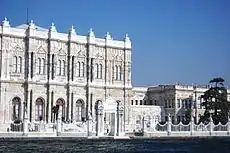
.jpg.webp)
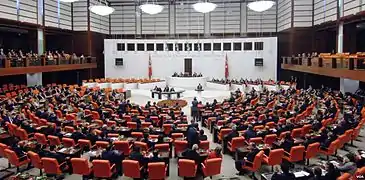

.jpg.webp)




.png.webp)

.jpg.webp)

.svg.png.webp)
.svg.png.webp)
.svg.png.webp)
